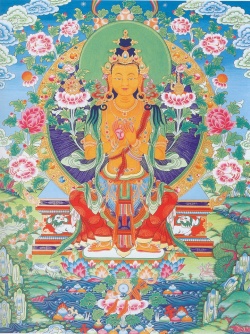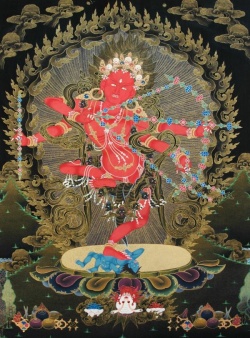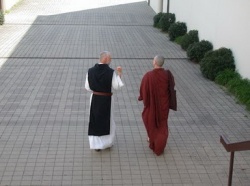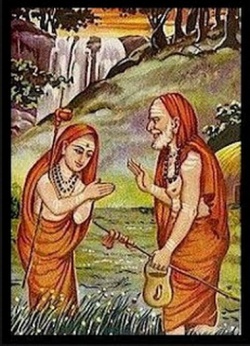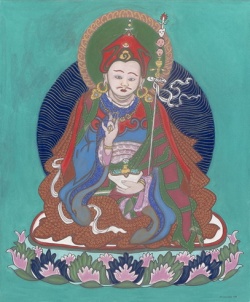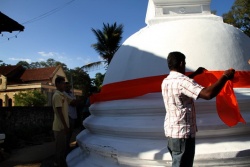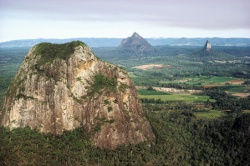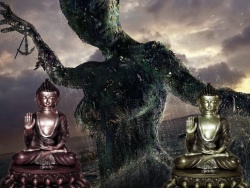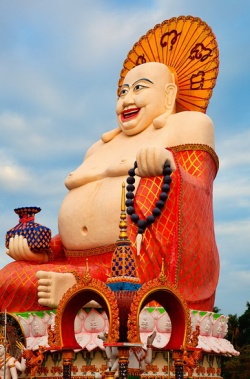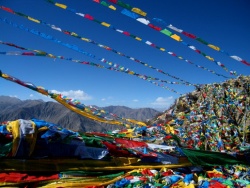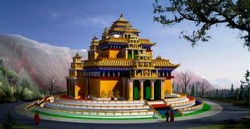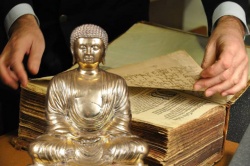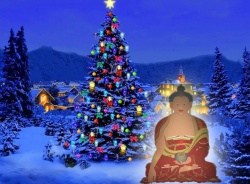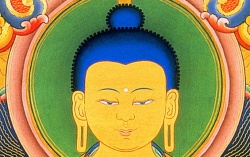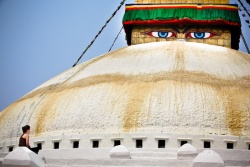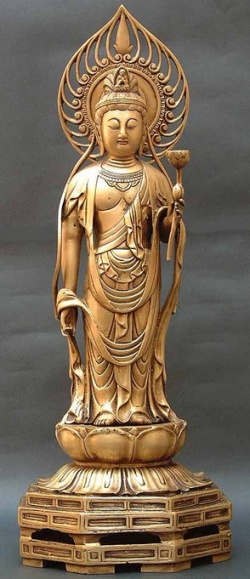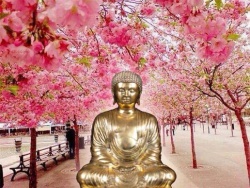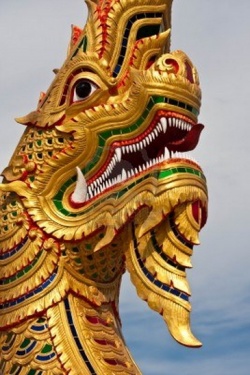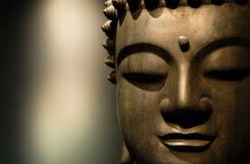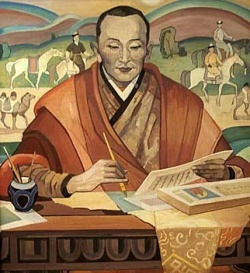Difference between revisions of "Buddhism without the Vinaya?"
m (Text replacement - "most ancient" to "most ancient") |
|||
| Line 5: | Line 5: | ||
The [[idea]] that [[Buddhism]] could [[exist]] without the [[Vinaya]] is imaginable given the [[reality]] of [[non-monastic]] [[Buddhist traditions]] having thrived throughout history (figures like [[Padmasambhava]] and [[Milarepa]] come to [[mind]]), but there has historically been [[Buddhist monasticism]] as well without the formal [[Vinaya]]. Here I want to review some examples of this, especially how such a system existed in {{Wiki|East Asia}}. | The [[idea]] that [[Buddhism]] could [[exist]] without the [[Vinaya]] is imaginable given the [[reality]] of [[non-monastic]] [[Buddhist traditions]] having thrived throughout history (figures like [[Padmasambhava]] and [[Milarepa]] come to [[mind]]), but there has historically been [[Buddhist monasticism]] as well without the formal [[Vinaya]]. Here I want to review some examples of this, especially how such a system existed in {{Wiki|East Asia}}. | ||
| − | The [[Vinaya]] is [[essentially]] a [[prātimokṣa]] or [[body]] of formal [[precepts]] that when properly received via the appropriate {{Wiki|ecclesiastical}} procedures legally makes one a [[bhikṣu]] ([[monk]]) or [[bhikṣuṇī]] ([[nun]]). There are multiple [[Vinaya]] texts as each [[ancient school]] of [[Indian Buddhism]] had their own version, but generally the rules themselves are more or less [[identical]] (the recorded incidents which led to the rules do differ). However, the number of [[precepts]] can significantly differ. For example, the [[Mahāsāṃghika Vinaya]] has 218 [[bhikṣu]] [[precepts]] while the [[Dharmaguptaka Vinaya]] has 250. Despite these differences it seems all [[Indian]] schools still [[recognized]] the ordinations carried out by their rivals. | + | The [[Vinaya]] is [[essentially]] a [[prātimokṣa]] or [[body]] of formal [[precepts]] that when properly received via the appropriate {{Wiki|ecclesiastical}} procedures legally makes one a [[bhikṣu]] ([[monk]]) or [[bhikṣuṇī]] ([[nun]]). There are multiple [[Vinaya]] texts as each [[ancient school]] of [[Indian Buddhism]] had their [[own]] version, but generally the {{Wiki|rules}} themselves are more or less [[identical]] (the recorded incidents which led to the {{Wiki|rules}} do differ). However, the number of [[precepts]] can significantly differ. For example, the [[Mahāsāṃghika Vinaya]] has 218 [[bhikṣu]] [[precepts]] while the [[Dharmaguptaka Vinaya]] has 250. Despite these differences it seems all [[Indian]] schools still [[recognized]] the ordinations carried out by their rivals. |
| − | A [[precept]] that an {{Wiki|individual}} receives at their [[ordination]] was originally a rule laid down by the [[Buddha]] following a disruptive incident, though the various [[Vinaya]] texts differ in the details of these incidents, which suggests these accounts are somewhat ahistorical or even fictional at times, especially given the [[supernatural]] [[elements]] (like [[sentient]] vegetation on its own accord concealing an {{Wiki|intoxicated}} [[monk]] who collapsed). | + | A [[precept]] that an {{Wiki|individual}} receives at their [[ordination]] was originally a {{Wiki|rule}} laid down by the [[Buddha]] following a disruptive incident, though the various [[Vinaya]] texts differ in the details of these incidents, which suggests these accounts are somewhat ahistorical or even fictional at times, especially given the [[supernatural]] [[elements]] (like [[sentient]] vegetation on its [[own]] accord concealing an {{Wiki|intoxicated}} [[monk]] who collapsed). |
| − | These house rules became formal [[vows]] or [[precepts]] that became required in order for one to be made a legitimate and fully [[recognized]] [[bhikṣu]] or [[bhikṣuṇī]]. For instance, as we explored in an earlier post [[Alcohol Prohibition in Buddhism]], [[alcohol]] consumption was formally forbidden following an incident where [[Bhikṣu]] [[Svāgata]] drank too much following {{Wiki|celebrations}} after he had non-violently defeated a troublesome [[nāga]] named Āmra. Prior to this, at least according to some {{Wiki|literature}}, bhikṣu-s did in fact knowingly consume [[alcohol]] as it was not prohibited. | + | These house {{Wiki|rules}} became formal [[vows]] or [[precepts]] that became required in order for one to be made a legitimate and fully [[recognized]] [[bhikṣu]] or [[bhikṣuṇī]]. For instance, as we explored in an earlier post [[Alcohol Prohibition in Buddhism]], [[alcohol]] consumption was formally forbidden following an incident where [[Bhikṣu]] [[Svāgata]] drank too much following {{Wiki|celebrations}} after he had non-violently defeated a troublesome [[nāga]] named Āmra. Prior to this, at least according to some {{Wiki|literature}}, bhikṣu-s did in fact knowingly consume [[alcohol]] as it was not prohibited. |
| − | The [[precept]] system as we know it now was a later [[development]] in the centuries following the [[death]] of the [[Buddha]] as things became systematized and the canon(s) settled. As far as most [[Buddhists]] throughout history were concerned, however, the events and decrees in the [[Vinaya]] {{Wiki|literature}} were historical records, and perhaps some of the events included therein do reflect {{Wiki|cultural}} [[memories]] of what actually happened, but the differing accounts renders any definitive conclusions problematic. Contemporary [[scholars]] rightfully contest such notions based on textual analysis and {{Wiki|archaeological}} discoveries. For instance, Schopen believes that the [[Vinaya]] {{Wiki|literature}} and [[vihāra]] [[monastic]] system are in fact post-Aśoka (304-232 BCE): | + | The [[precept]] system as we know it now was a later [[development]] in the centuries following the [[death]] of the [[Buddha]] as things became systematized and the canon(s) settled. As far as most [[Buddhists]] throughout history were concerned, however, the events and decrees in the [[Vinaya]] {{Wiki|literature}} were historical records, and perhaps some of the events included therein do reflect {{Wiki|cultural}} [[memories]] of what actually happened, but the differing accounts renders any definitive conclusions problematic. Contemporary [[scholars]] rightfully contest such notions based on textual analysis and {{Wiki|archaeological}} discoveries. For instance, [[Schopen]] believes that the [[Vinaya]] {{Wiki|literature}} and [[vihāra]] [[monastic]] system are in fact post-Aśoka (304-232 BCE): |
| − | : If the compilers of the various [[Vinayas]] considered it ‘highly important’ to regulate the [[lives]] of their [[monks]] so as to give no [[cause]] for complaint to the laity, and if considerations of this sort could only have assumed high importance after [[buddhist]] groups had permanently settled down, then, since the latter almost certainly did not occur until well after [[Aśoka]], it would be obvious that all the [[Vinayas]] that we have are late, precisely as both Wassilieff and Lévi have suggested a hundred years ago. | + | : If the compilers of the various [[Vinayas]] considered it ‘highly important’ to regulate the [[lives]] of their [[monks]] so as to give no [[cause]] for complaint to the laity, and if considerations of this sort could only have assumed high importance after [[buddhist]] groups had permanently settled down, then, since the [[latter]] almost certainly did not occur until well after [[Aśoka]], it would be obvious that all the [[Vinayas]] that we have are late, precisely as both Wassilieff and Lévi have suggested a hundred years ago. |
: ... | : ... | ||
| Line 20: | Line 20: | ||
}}</ref> | }}</ref> | ||
| − | Even before this though there is an [[interesting]] point that needs to be [[recognized]] even within a [[Buddhist tradition]] that [[recognizes]] their [[Vinaya]] {{Wiki|literature}} as entirely legitimate: at one point there were bhikṣu-s without any [[precepts]]. As the story goes, over the course of the [[Buddha's]] fifty year [[teaching]] career he established new rules as incidents occurred. There was a [[time]] when the [[sangha]] effectively had no official rules or [[precepts]]. | + | Even before this though there is an [[interesting]] point that needs to be [[recognized]] even within a [[Buddhist tradition]] that [[recognizes]] their [[Vinaya]] {{Wiki|literature}} as entirely legitimate: at one point there were bhikṣu-s without any [[precepts]]. As the story goes, over the course of the [[Buddha's]] fifty year [[teaching]] career he established new {{Wiki|rules}} as incidents occurred. There was a [[time]] when the [[sangha]] effectively had no official {{Wiki|rules}} or [[precepts]]. |
The [[Mahāsāṃghika Vinaya]] records that the [[first precept]] the [[Buddha]] established for the bhikṣu-s was the [[precept]] against {{Wiki|sex}}: | The [[Mahāsāṃghika Vinaya]] records that the [[first precept]] the [[Buddha]] established for the bhikṣu-s was the [[precept]] against {{Wiki|sex}}: | ||
| Line 26: | Line 26: | ||
: 《摩訶僧祇律大比丘戒本》卷1:「佛在毘舍離城成佛五年冬分第五半月十二日。食後東向坐一人半影。為長老耶奢伽蘭陀子制此戒。已制當隨順行。是名隨順法。」(CBETA, T22, no. 1426, p. 549, c1-3) | : 《摩訶僧祇律大比丘戒本》卷1:「佛在毘舍離城成佛五年冬分第五半月十二日。食後東向坐一人半影。為長老耶奢伽蘭陀子制此戒。已制當隨順行。是名隨順法。」(CBETA, T22, no. 1426, p. 549, c1-3) | ||
| − | : The [[Buddha]] was in [[Vaiśālī]]. It was five years following his [[enlightenment]]. It was the fifth half-moon of winter on the twelfth day when after eating he sat eastward with a man's half-shadow. He then established this [[precept]] for the elder Yaśa [[Kalandaka]] Putra. Having been established, one should be in accord and carry it out. This is called the [[Dharma]] of being in accord. | + | : The [[Buddha]] was in [[Vaiśālī]]. It was five years following his [[enlightenment]]. It was the fifth half-moon of winter on the twelfth day when after eating he sat eastward with a man's half-shadow. He then established this [[precept]] for the elder Yaśa [[Kalandaka]] [[Putra]]. Having been established, one should be in accord and carry it out. This is called the [[Dharma]] of being in accord. |
Of the various extant [[Vinayas]] in {{Wiki|Chinese}} translation it is only the [[Mahāsāṃghika Vinaya]] which records the approximate date and [[time]] for when [[precepts]] were established, but this is only limited to the four pārājika-s (the [[precepts]] against {{Wiki|sex}}, theft, {{Wiki|lying}} and homicide). | Of the various extant [[Vinayas]] in {{Wiki|Chinese}} translation it is only the [[Mahāsāṃghika Vinaya]] which records the approximate date and [[time]] for when [[precepts]] were established, but this is only limited to the four pārājika-s (the [[precepts]] against {{Wiki|sex}}, theft, {{Wiki|lying}} and homicide). | ||
| Line 32: | Line 32: | ||
The [[Mahāsāṃghika Vinaya]] is unique in that {{Wiki|modern}} [[scholars]] have concluded that it is the earliest rendition of a [[Vinaya]] text available to us, though from the {{Wiki|perspective}} of the original [[Mahāsāṃghika]] school itself this was also true even in {{Wiki|ancient}} times. Nattier and Prebish in “[[Mahāsāṃghika]] Origins: The Beginnings of [[Buddhist]] {{Wiki|Sectarianism}}” explain: | The [[Mahāsāṃghika Vinaya]] is unique in that {{Wiki|modern}} [[scholars]] have concluded that it is the earliest rendition of a [[Vinaya]] text available to us, though from the {{Wiki|perspective}} of the original [[Mahāsāṃghika]] school itself this was also true even in {{Wiki|ancient}} times. Nattier and Prebish in “[[Mahāsāṃghika]] Origins: The Beginnings of [[Buddhist]] {{Wiki|Sectarianism}}” explain: | ||
| − | : ...the real issue culminating in the [[schism]] was [[Vinaya]] expansion. The [[Mahāsāṃghika]] are designated in the passage as those who study the "{{Wiki|ancient}} [[Vinaya]]," and this tallies extremely well with the conclusions of Bareau, Pachow, Hofinger, {{Wiki|Frauwallner}}, and Roth that the [[Mahāsāṃghika Vinaya]] represents the most ancient all [[Vinaya]] [[traditions]].<ref>{{Nolinking|See Janice J. Nattier and Charles S. Prebish, “Mahāsāṃghika Origins: The Beginnings of Buddhist Sectarianism” in History of Religions, Vol. 16, No. 3, February (Chicago: The University of Chicago Press, 1997), 267.}}</ref> | + | : ...the real issue culminating in the [[schism]] was [[Vinaya]] expansion. The [[Mahāsāṃghika]] are designated in the passage as those who study the "{{Wiki|ancient}} [[Vinaya]]," and this tallies extremely well with the conclusions of Bareau, Pachow, Hofinger, {{Wiki|Frauwallner}}, and Roth that the [[Mahāsāṃghika Vinaya]] represents the most [[ancient]] all [[Vinaya]] [[traditions]].<ref>{{Nolinking|See Janice J. Nattier and Charles S. Prebish, “Mahāsāṃghika Origins: The Beginnings of Buddhist Sectarianism” in History of Religions, Vol. 16, No. 3, February (Chicago: The University of Chicago Press, 1997), 267.}}</ref> |
| − | In {{Wiki|light}} of the {{Wiki|modern}} [[debate]] above about the historicity of Vinaya-based {{Wiki|institutions}} and {{Wiki|literature}}, the approximate dates for the formulation of the first [[precepts]] are likewise to be called into question, though it does demonstrate at the very least that at one point there were bhikṣu-s and a [[sangha]] with no [[precepts]], thus technically {{Wiki|speaking}} the legal [[definition]] of a [[bhikṣu]] as being someone with the full [[precepts]] only applies to those {{Wiki|individuals}} who would have [[ordained]] after all such rules had been established. | + | In {{Wiki|light}} of the {{Wiki|modern}} [[debate]] above about the historicity of Vinaya-based {{Wiki|institutions}} and {{Wiki|literature}}, the approximate dates for the formulation of the first [[precepts]] are likewise to be called into question, though it does demonstrate at the very least that at one point there were bhikṣu-s and a [[sangha]] with no [[precepts]], thus technically {{Wiki|speaking}} the legal [[definition]] of a [[bhikṣu]] as being someone with the full [[precepts]] only applies to those {{Wiki|individuals}} who would have [[ordained]] after all such {{Wiki|rules}} had been established. |
This is why the [[Vinaya]] [[tradition]] still [[recognizes]] a class of bhikṣu-s who did not in fact receive any [[precepts]] yet still were considered legitimate [[monks]]. The technical term for this is svāgata-bhikṣu which means “welcomed [[bhikṣu]]”. This was where the [[Buddha]] himself welcomed an {{Wiki|individual}} to join the [[sangha]], which thereby made them a legitimate [[bhikṣu]]. There are numerous examples of {{Wiki|individuals}} becoming such bhikṣu-s during the early phase of the [[sangha]]: | This is why the [[Vinaya]] [[tradition]] still [[recognizes]] a class of bhikṣu-s who did not in fact receive any [[precepts]] yet still were considered legitimate [[monks]]. The technical term for this is svāgata-bhikṣu which means “welcomed [[bhikṣu]]”. This was where the [[Buddha]] himself welcomed an {{Wiki|individual}} to join the [[sangha]], which thereby made them a legitimate [[bhikṣu]]. There are numerous examples of {{Wiki|individuals}} becoming such bhikṣu-s during the early phase of the [[sangha]]: | ||
| Line 57: | Line 57: | ||
So how did the early [[sangha]] [[function]] without [[precepts]]? In {{Wiki|ancient}} [[Magadha]] in the [[time]] of the [[Buddha]], there was a widespread [[śramaṇa]] ({{Wiki|mendicant}} renunciate) {{Wiki|culture}} with common values which the [[Buddha's]] first [[disciples]] would have already cultivated themselves or at least been quite familiar with. The {{Wiki|culture}} valued [[celibacy]] ([[brahmacarya]]), [[non-violence]] ([[ahiṃsā]]), sobriety, [[meditation]] and being abstemious. | So how did the early [[sangha]] [[function]] without [[precepts]]? In {{Wiki|ancient}} [[Magadha]] in the [[time]] of the [[Buddha]], there was a widespread [[śramaṇa]] ({{Wiki|mendicant}} renunciate) {{Wiki|culture}} with common values which the [[Buddha's]] first [[disciples]] would have already cultivated themselves or at least been quite familiar with. The {{Wiki|culture}} valued [[celibacy]] ([[brahmacarya]]), [[non-violence]] ([[ahiṃsā]]), sobriety, [[meditation]] and being abstemious. | ||
| − | One of the [[Buddha's]] contemporaries the 24th Tīrthaṅkara [[Mahāvīra]] shared most of the same basic {{Wiki|principles}} with the [[Buddha]] and other such śramaṇa-s. The early [[sangha]] presumably would have been [[ethically]] united by [[virtue]] of such common values and the expectations they entailed. As a [[śramaṇa]] you were expected to maintain [[pure]] [[body, speech and mind]] ([[brahmacarya]]), thus any {{Wiki|sexual}} [[activity]] was to be avoided even in the absence of punitive measures against it. | + | One of the [[Buddha's]] contemporaries the 24th [[Tīrthaṅkara]] [[Mahāvīra]] shared most of the same basic {{Wiki|principles}} with the [[Buddha]] and other such śramaṇa-s. The early [[sangha]] presumably would have been [[ethically]] united by [[virtue]] of such common values and the expectations they entailed. As a [[śramaṇa]] you were expected to maintain [[pure]] [[body, speech and mind]] ([[brahmacarya]]), thus any {{Wiki|sexual}} [[activity]] was to be avoided even in the absence of punitive measures against it. |
| − | As the story goes, however, later on problematic {{Wiki|individuals}} joined the [[sangha]] and incidents arose leading to a need for formal rules and punitive measures to be implemented. These could be revised in the [[Buddha's]] day and he himself according to the [[Vinaya]] encouraged the regulations to be modified as necessary. The [[Mahīśāsaka Vinaya]] in Classical {{Wiki|Chinese}} translation (translated by [[Buddhajīva]] and [[Daosheng]] [[道生]] between 423-434) quotes the [[Buddha]] as follows: | + | As the story goes, however, later on problematic {{Wiki|individuals}} joined the [[sangha]] and incidents arose leading to a need for formal {{Wiki|rules}} and punitive measures to be implemented. These could be revised in the [[Buddha's]] day and he himself according to the [[Vinaya]] encouraged the regulations to be modified as necessary. The [[Mahīśāsaka Vinaya]] in Classical {{Wiki|Chinese}} translation (translated by [[Buddhajīva]] and [[Daosheng]] [[道生]] between 423-434) quotes the [[Buddha]] as follows: |
: 《彌沙塞部和醯五分律》卷22:「雖是我所制。而於餘方不以為清淨者。皆不應用。雖非我所制。而於餘方必應行者。皆不得不行。」(CBETA, T22, no. 1421, p. 153, a14-17) | : 《彌沙塞部和醯五分律》卷22:「雖是我所制。而於餘方不以為清淨者。皆不應用。雖非我所制。而於餘方必應行者。皆不得不行。」(CBETA, T22, no. 1421, p. 153, a14-17) | ||
| Line 67: | Line 67: | ||
There is also the event where [[Ānanda]] was told by the [[Buddha]] that the [[sangha]] could “do away with the minor [[precepts]]”, though having failed to inquire which were the minor [[precepts]] he was unable to get a consensus on the {{Wiki|matter}} from the [[sangha]], resulting in [[Mahākāśyapa]] declaring that no [[precepts]] were to be abandoned. | There is also the event where [[Ānanda]] was told by the [[Buddha]] that the [[sangha]] could “do away with the minor [[precepts]]”, though having failed to inquire which were the minor [[precepts]] he was unable to get a consensus on the {{Wiki|matter}} from the [[sangha]], resulting in [[Mahākāśyapa]] declaring that no [[precepts]] were to be abandoned. | ||
| − | This begs the question on what authority he made such a declaration given the supposedly democratic and {{Wiki|egalitarian}} [[nature]] of the [[sangha]]. Apparently the other [[arhats]] in attendance had differing opinions, which means no consensus had been reached, yet [[Mahākāśyapa]] disregarded democratic procedures and on his own seemingly autocratic authority declared what he did. From the {{Wiki|perspective}} of [[Vinaya]] law, his declaration could been seen as invalid since the policy was not put to {{Wiki|motion}} to be passed through unanimous consensus (and the record states the other [[arhats]] {{Wiki|present}} at the meeting had differing opinions). That effectively means that the issue of [[abandoning]] minor [[precepts]] is still unresolved regardless of whatever personal opinion [[Mahākāśyapa]] forced onto the [[sangha]]. In other words, a [[sangha]] could in {{Wiki|theory}} proceed with [[abandoning]] the minor [[precepts]] based on their own conclusions of which [[precepts]] are minor. | + | This begs the question on what authority he made such a declaration given the supposedly democratic and {{Wiki|egalitarian}} [[nature]] of the [[sangha]]. Apparently the other [[arhats]] in attendance had differing opinions, which means no consensus had been reached, yet [[Mahākāśyapa]] disregarded democratic procedures and on his [[own]] seemingly autocratic authority declared what he did. From the {{Wiki|perspective}} of [[Vinaya]] law, his declaration could been seen as invalid since the policy was not put to {{Wiki|motion}} to be passed through unanimous consensus (and the record states the other [[arhats]] {{Wiki|present}} at the meeting had differing opinions). That effectively means that the issue of [[abandoning]] minor [[precepts]] is still unresolved regardless of whatever personal opinion [[Mahākāśyapa]] forced onto the [[sangha]]. In other words, a [[sangha]] could in {{Wiki|theory}} proceed with [[abandoning]] the minor [[precepts]] based on their [[own]] conclusions of which [[precepts]] are minor. |
| − | This all demonstrates that the [[precepts]] were only provisional and adaptable where necessary. As [[time]] went on and [[Buddhism]] evolved, organized landed [[monasticism]] developed perhaps as a result of {{Wiki|social}} pressures, and the [[Vinaya]] [[traditions]] were formulated by the various sects. Early [[Mahāyāna]] {{Wiki|literature}} like [[Vimalakīrti Sūtra]] emerged around the same [[time]] and curiously mocks preoccupation with rules (like [[Śāriputra]] complaining about being showered with [[flowers]] by the [[goddess]] and unable to wipe them away). | + | This all demonstrates that the [[precepts]] were only provisional and adaptable where necessary. As [[time]] went on and [[Buddhism]] evolved, organized landed [[monasticism]] developed perhaps as a result of {{Wiki|social}} pressures, and the [[Vinaya]] [[traditions]] were formulated by the various sects. Early [[Mahāyāna]] {{Wiki|literature}} like [[Vimalakīrti Sūtra]] emerged around the same [[time]] and curiously mocks preoccupation with {{Wiki|rules}} (like [[Śāriputra]] complaining about being showered with [[flowers]] by the [[goddess]] and unable to wipe them away). |
| − | Another [[interesting]] point in this [[respect]] is the [[mythic]] accounts of the first three of the seven {{Wiki|past}} [[buddhas]] ([[Vipaśyin]], Śikhin and [[Viśvabhū]]) who never established any [[precepts]] as there was no need. This means that not all [[buddhas]] establish a [[Vinaya]], as was the case of [[Śākyamuni Buddha]] for the first five years of his [[teaching]] career. The [[Vinaya]] therefore is not necessarily an [[essential]] component of [[Buddhadharma]], yet the {{Wiki|orthodox}} line of [[thought]] has generally been that it is in fact sacrosanct and therefore indispensable. Early on in the [[history of Buddhism]] we see the text [[Milindapanha]] (the [[Questions of Milinda]]) displaying just such notions and even saying anyone becoming an [[arhat]] outside the [[sangha]] has to [[die]] within a day: | + | Another [[interesting]] point in this [[respect]] is the [[mythic]] accounts of the first three of the seven {{Wiki|past}} [[buddhas]] ([[Vipaśyin]], [[Śikhin]] and [[Viśvabhū]]) who never established any [[precepts]] as there was no need. This means that not all [[buddhas]] establish a [[Vinaya]], as was the case of [[Śākyamuni Buddha]] for the first five years of his [[teaching]] career. The [[Vinaya]] therefore is not necessarily an [[essential]] component of [[Buddhadharma]], yet the {{Wiki|orthodox}} line of [[thought]] has generally been that it is in fact sacrosanct and therefore indispensable. Early on in the [[history of Buddhism]] we see the text [[Milindapanha]] (the [[Questions of Milinda]]) displaying just such notions and even saying anyone becoming an [[arhat]] outside the [[sangha]] has to [[die]] within a day: |
: "If a [[layman]] attains [[arahant-ship]], only two destinations await him; either he must enter the Order that very day or else he must attain parinibbàna" | : "If a [[layman]] attains [[arahant-ship]], only two destinations await him; either he must enter the Order that very day or else he must attain parinibbàna" | ||
| Line 78: | Line 78: | ||
: "You say that if a [[layman]] attains [[arahantship]] he must either enter the Order that very day or [[die]] and attain parinibbàna. Yet if he is unable to find a robe and [[bowl]] and [[preceptor]] then that [[exalted]] [[condition]] of [[arahantship]] is a waste, for destruction of [[life]] is involved in it." | : "You say that if a [[layman]] attains [[arahantship]] he must either enter the Order that very day or [[die]] and attain parinibbàna. Yet if he is unable to find a robe and [[bowl]] and [[preceptor]] then that [[exalted]] [[condition]] of [[arahantship]] is a waste, for destruction of [[life]] is involved in it." | ||
| − | : "The fault does not lie with [[arahantship]] but with the state of a [[layman]], because it is too weak to support [[arahantship]]. Just as, O [[king]], although [[food]] protects the [[life]] of [[beings]] it will take away the [[life]] of one whose {{Wiki|digestion}} is weak; so too, if a [[layman]] attains [[arahantship]] he must, because of the weakness of that [[condition]], enter the Order that very day or [[die]]." | + | : "The fault does not lie with [[arahantship]] but with the [[state]] of a [[layman]], because it is too weak to support [[arahantship]]. Just as, O [[king]], although [[food]] protects the [[life]] of [[beings]] it will take away the [[life]] of one whose {{Wiki|digestion}} is weak; so too, if a [[layman]] attains [[arahantship]] he must, because of the weakness of that [[condition]], enter the Order that very day or [[die]]." |
:: [[Milindapanha]] III.62 | :: [[Milindapanha]] III.62 | ||
| − | Was [[Nāgasena]] {{Wiki|aware}} that [[Vipaśyin]], Śikhin and [[Viśvabhū]] never established [[monastic]] orders? Did it mean back then everyone who became an [[arhat]] [[died]] within a day for lack of a robe, [[bowl]] and [[preceptor]]? Quite possibly in Nāgasena's [[time]] the [[myth]] of the {{Wiki|past}} [[buddhas]] was not universally known or accepted, or perhaps the author of the [[Milindapanha]] was unaware of his {{Wiki|contradiction}}. The text is clearly looking at securing a monopoly on living [[arhats]] for the formally [[ordained]] [[sangha]] (note: robe, [[bowl]] and [[preceptor]] as prerequisites for [[ordination]]) all the while eliminating the possibility of laypeople having their own living [[arhats]] (see an earlier post [[Power and Inequality in Buddhism]]). This seems to have been more of a power grab than anything else and perhaps reveals corrupting [[influences]] early on in the [[sangha]] as this is clearly an opportunistic seizure of [[religious]] power at the expense of the laity. In any case, such notions as laity dying prematurely as a result of achieving [[arhatship]] are easily refuted. | + | Was [[Nāgasena]] {{Wiki|aware}} that [[Vipaśyin]], [[Śikhin]] and [[Viśvabhū]] never established [[monastic]] orders? Did it mean back then everyone who became an [[arhat]] [[died]] within a day for lack of a robe, [[bowl]] and [[preceptor]]? Quite possibly in Nāgasena's [[time]] the [[myth]] of the {{Wiki|past}} [[buddhas]] was not universally known or accepted, or perhaps the author of the [[Milindapanha]] was unaware of his {{Wiki|contradiction}}. The text is clearly looking at securing a monopoly on living [[arhats]] for the formally [[ordained]] [[sangha]] (note: robe, [[bowl]] and [[preceptor]] as prerequisites for [[ordination]]) all the while eliminating the possibility of [[laypeople]] having their [[own]] living [[arhats]] (see an earlier post [[Power and Inequality in Buddhism]]). This seems to have been more of a power grab than anything else and perhaps reveals corrupting [[influences]] early on in the [[sangha]] as this is clearly an opportunistic seizure of [[religious]] power at the expense of the laity. In any case, such notions as laity dying prematurely as a result of achieving [[arhatship]] are easily refuted. |
| − | Outside of [[India]] in [[China]] the history of the [[Vinaya]] becomes especially [[interesting]]. As the story goes, the official start of [[Buddhism in China]] commences with [[Wikipedia:Emperor Ming of Han|Emperor Ming]] 明帝 (28-75) in the [[Eastern Han Dynasty]] (28-75) having a [[dream]] of a golden man. Upon explaining this to his advisers they suggested it was the [[Buddha]] he had seen in his [[dream]]. A delegation was dispatched to [[India]] to fetch [[Buddha's teachings]]. The {{Wiki|Book of the Later Han}} 後漢書 (the history of the Eastern Han) records the incident as follows: | + | Outside of [[India]] in [[China]] the history of the [[Vinaya]] becomes especially [[interesting]]. As the story goes, the official start of [[Buddhism in China]] commences with [[Wikipedia:Emperor Ming of Han|Emperor Ming]] [[明帝]] (28-75) in the [[Eastern Han Dynasty]] (28-75) having a [[dream]] of a golden man. Upon explaining this to his advisers they suggested it was the [[Buddha]] he had seen in his [[dream]]. A delegation was dispatched to [[India]] to fetch [[Buddha's teachings]]. The {{Wiki|Book of the Later Han}} [[後漢書]] (the history of the Eastern Han) records the incident as follows: |
: 世傳明帝夢見金人,長大,頂有光明,以問群臣。或曰:“西方有神,名曰佛,其形長丈六尺而黃金色。”帝於是遣使天竺問佛道法,遂於中國圖畫形像焉。楚王英始信其術,中國因此頗有奉其道者。... | : 世傳明帝夢見金人,長大,頂有光明,以問群臣。或曰:“西方有神,名曰佛,其形長丈六尺而黃金色。”帝於是遣使天竺問佛道法,遂於中國圖畫形像焉。楚王英始信其術,中國因此頗有奉其道者。... | ||
| Line 89: | Line 89: | ||
: It has been passed down through the generations that [[Wikipedia:Emperor Ming of Han|Emperor Ming]] had seen a golden man in a [[dream]] who was big and tall with a [[halo]] atop his head. He asked his ministers about this. One suggested, "In the [[west]] there is a [[spirit]] named [[Buddha]]. His figure is one zhang and six [[chi]] tall and his {{Wiki|colour}} is golden yellow." The [[Emperor]] in response to this dispatched a delegation to [[India]] to ask of the [[Buddha's]] way and methods. They succeeded in bringing back images and sculptures back to [[China]]. Chuwang [[Ying]] started to have [[faith]] in the [[arts]] [of [[Buddhism]] ]. It is because of this that [[China]] has many who believe in the ways [of the [[Buddha]]]. ... | : It has been passed down through the generations that [[Wikipedia:Emperor Ming of Han|Emperor Ming]] had seen a golden man in a [[dream]] who was big and tall with a [[halo]] atop his head. He asked his ministers about this. One suggested, "In the [[west]] there is a [[spirit]] named [[Buddha]]. His figure is one zhang and six [[chi]] tall and his {{Wiki|colour}} is golden yellow." The [[Emperor]] in response to this dispatched a delegation to [[India]] to ask of the [[Buddha's]] way and methods. They succeeded in bringing back images and sculptures back to [[China]]. Chuwang [[Ying]] started to have [[faith]] in the [[arts]] [of [[Buddhism]] ]. It is because of this that [[China]] has many who believe in the ways [of the [[Buddha]]]. ... | ||
| − | Between [[Emperor]] Ming's [[time]] ([[died]] 75 CE) and the {{Wiki|Three Kingdoms}} period (220-280) there seems to have been no official [[Vinaya]] [[tradition]] in [[China]]. In 250 it was under [[Emperor]] Fei of Wei 魏廢帝 (232–274) in his {{Wiki|Kingdom}} of Cao Wei 曹魏 that a [[monk]] named [[Dharmakāla]] from Central [[India]] translated the [[Heart]] of the [[Sangha]] [[Precepts]] 僧祇戒心 and the Four Part [[Karma]] Proceedings 四分羯磨. This was carried out at the famous [[White Horse Temple]] 白馬寺 in [[Luoyang]]. | + | Between [[Emperor]] Ming's [[time]] ([[died]] 75 CE) and the {{Wiki|Three Kingdoms}} period (220-280) there seems to have been no official [[Vinaya]] [[tradition]] in [[China]]. In 250 it was under [[Emperor]] Fei of Wei 魏廢帝 (232–274) in his {{Wiki|Kingdom}} of Cao Wei [[曹魏]] that a [[monk]] named [[Dharmakāla]] from Central [[India]] translated the [[Heart]] of the [[Sangha]] [[Precepts]] 僧祇戒心 and the Four Part [[Karma]] Proceedings 四分羯磨. This was carried out at the famous [[White Horse Temple]] 白馬寺 in [[Luoyang]]. |
We can assume that some {{Wiki|Chinese}} [[monks]] were formally [[ordained]] as bhikṣu-s at this point, but clearly this was not widespread. At the [[time]] there was no complete [[prātimokṣa]] translated into {{Wiki|Chinese}}, which some [[time]] later became a stated [[reason]] for [[Faxian]] [[法顯]] (338-c423) traveling to [[India]] to collect [[Vinaya]] texts. | We can assume that some {{Wiki|Chinese}} [[monks]] were formally [[ordained]] as bhikṣu-s at this point, but clearly this was not widespread. At the [[time]] there was no complete [[prātimokṣa]] translated into {{Wiki|Chinese}}, which some [[time]] later became a stated [[reason]] for [[Faxian]] [[法顯]] (338-c423) traveling to [[India]] to collect [[Vinaya]] texts. | ||
| Line 125: | Line 125: | ||
|} | |} | ||
| − | The [[Mūlasarvāstivāda Vinaya]] is noteworthy because it displays some explicit [[Mahāyāna]] [[elements]] such as mention of a [[Mahāyāna]] in contrast to the [[śrāvaka]] and [[pratyekabuddha]] [[paths]], plus the [[Buddha]] using “[[bodhisattva]] practices to [[transform]] [[beings]]”.<ref>{{Nolinking|《根本說一切有部毘奈耶》卷19:「以菩薩行化諸有情」(CBETA, T23, no. 1442, p. 726, a28)《根本說一切有部毘奈耶》卷45:「乃至出家得阿羅漢果。或有發趣聲聞獨覺乘心者。或有發趣大乘者。」(CBETA, T23, no. 1442, p. 875, b20-22)}}</ref> This is remarkable because it clearly illustrates some [[Indian]] [[monks]] did not [[view]] their {{Wiki|archaic}} [[Vinaya]] texts as sacrosanct enough to leave them unmodified (that is assuming the [[translator]] [[Yijing]] did not make such modifications himself, but I have no [[reason]] to believe this to be the case). Said [[Vinaya]] text was perhaps in use around the [[Nālandā]] area, which was a rather innovative {{Wiki|community}} of [[scholars]] and [[yogis]] which regularly mixed [[elements]] from [[Mahāyāna]] and [[Śrāvakayāna]] sources. This would have been a significant [[doctrinal]] modification on their part given that the [[Vinaya]] was supposed to have been largely settled and set in stone, yet clearly some [[Indian]] [[monks]] felt free to update and revise their own [[prātimokṣa]]. | + | The [[Mūlasarvāstivāda Vinaya]] is noteworthy because it displays some explicit [[Mahāyāna]] [[elements]] such as mention of a [[Mahāyāna]] in contrast to the [[śrāvaka]] and [[pratyekabuddha]] [[paths]], plus the [[Buddha]] using “[[bodhisattva]] practices to [[transform]] [[beings]]”.<ref>{{Nolinking|《根本說一切有部毘奈耶》卷19:「以菩薩行化諸有情」(CBETA, T23, no. 1442, p. 726, a28)《根本說一切有部毘奈耶》卷45:「乃至出家得阿羅漢果。或有發趣聲聞獨覺乘心者。或有發趣大乘者。」(CBETA, T23, no. 1442, p. 875, b20-22)}}</ref> This is remarkable because it clearly illustrates some [[Indian]] [[monks]] did not [[view]] their {{Wiki|archaic}} [[Vinaya]] texts as sacrosanct enough to leave them unmodified (that is assuming the [[translator]] [[Yijing]] did not make such modifications himself, but I have no [[reason]] to believe this to be the case). Said [[Vinaya]] text was perhaps in use around the [[Nālandā]] area, which was a rather innovative {{Wiki|community}} of [[scholars]] and [[yogis]] which regularly mixed [[elements]] from [[Mahāyāna]] and [[Śrāvakayāna]] sources. This would have been a significant [[doctrinal]] modification on their part given that the [[Vinaya]] was supposed to have been largely settled and set in stone, yet clearly some [[Indian]] [[monks]] felt free to update and revise their [[own]] [[prātimokṣa]]. |
| − | Despite these texts having been translated it seems the procedures contained therein were never fully implemented in [[China]]. The {{Wiki|modern}} [[scholar]] [[Sheng Yen]] (1930-2009) in his research on the [[Vinaya]] stated that [[Chinese Buddhism]] did not carry out the [[karma]] proceedings any longer, but moreover he also notes that other components to the [[Vinaya]] like the “eight rules of [[respect]]” (the eight rules a [[bhikṣuṇī]] follows in [[respect]] to venerating and deferring to bhikṣu-s) were never carried out according to regulations ever in {{Wiki|Chinese}} history. | + | Despite these texts having been translated it seems the procedures contained therein were never fully implemented in [[China]]. The {{Wiki|modern}} [[scholar]] [[Sheng Yen]] (1930-2009) in his research on the [[Vinaya]] stated that [[Chinese Buddhism]] did not carry out the [[karma]] proceedings any longer, but moreover he also notes that other components to the [[Vinaya]] like the “eight {{Wiki|rules}} of [[respect]]” (the eight {{Wiki|rules}} a [[bhikṣuṇī]] follows in [[respect]] to venerating and deferring to bhikṣu-s) were never carried out according to regulations ever in {{Wiki|Chinese}} history. |
| − | This is noteworthy because in {{Wiki|ancient}} times some {{Wiki|Chinese}} [[monks]] noted how well [[disciplined]] [[Indian]] [[monastics]] were compared to their own kin. A lot of the [[precepts]] and complex procedures as outlined in the [[Vinaya]] {{Wiki|literature}} were ignored in [[China]]. | + | This is noteworthy because in {{Wiki|ancient}} times some {{Wiki|Chinese}} [[monks]] noted how well [[disciplined]] [[Indian]] [[monastics]] were compared to their [[own]] kin. A lot of the [[precepts]] and complex procedures as outlined in the [[Vinaya]] {{Wiki|literature}} were ignored in [[China]]. |
Interestingly, [[Faxian]] in [[India]] lost a compatriot companion Daozheng who lamented how wretched [[discipline]] was in [[China]]: | Interestingly, [[Faxian]] in [[India]] lost a compatriot companion Daozheng who lamented how wretched [[discipline]] was in [[China]]: | ||
| Line 141: | Line 141: | ||
In his works he sometimes laments how {{Wiki|Chinese}} [[monastics]] simply got things wrong. For instance, {{Wiki|Chinese}} [[monks]] used the [[niṣīdana]] as a floor cover for [[prostrations]], whereas the prescribed [[function]] of the cloth is to cover furniture and seating so as not to soil it (this is especially useful for {{Wiki|mendicants}} who might [[sleep]] outside and then visit the homes of benefactors). [[Yijing]] said it was never used as a floor cover for [[prostrations]] anywhere in [[India]]. He also said that “[[bhikṣus]] of {{Wiki|western}} lands” ({{Wiki|Indians}}) would [[laugh]] at [[seeing]] this. Curiously despite this being known since {{Wiki|ancient}} times, {{Wiki|Chinese}} [[monks]] still use it for [[prostrations]]. Such mistaken understandings became formal and [[sacred]] customs. | In his works he sometimes laments how {{Wiki|Chinese}} [[monastics]] simply got things wrong. For instance, {{Wiki|Chinese}} [[monks]] used the [[niṣīdana]] as a floor cover for [[prostrations]], whereas the prescribed [[function]] of the cloth is to cover furniture and seating so as not to soil it (this is especially useful for {{Wiki|mendicants}} who might [[sleep]] outside and then visit the homes of benefactors). [[Yijing]] said it was never used as a floor cover for [[prostrations]] anywhere in [[India]]. He also said that “[[bhikṣus]] of {{Wiki|western}} lands” ({{Wiki|Indians}}) would [[laugh]] at [[seeing]] this. Curiously despite this being known since {{Wiki|ancient}} times, {{Wiki|Chinese}} [[monks]] still use it for [[prostrations]]. Such mistaken understandings became formal and [[sacred]] customs. | ||
| − | In [[China]] the state might have normally sanctioned the [[Vinaya]] and Vinaya-based ordinations, though in [[reality]] things worked different on the ground in practice. In [[China]] the [[Dharmaguptaka Vinaya]] became the primary [[Vinaya]] after [[Dao'an]] 道岸 (654-717) utilized his connections under [[Wikipedia:Emperor Zhongzong of Tang |Emperor Zhongzong]] 中宗 (656-710) to have it imposed across the country, which probably occurred between 705-710. Prior to this the [[south]] had been using the [[Sarvāstivāda Vinaya]], whereas the [[north]] had largely used the [[Mahāsāṃghika Vinaya]] until [[Daoxuan]] [[道宣]] (596-667) and his commentary [[tradition]] on the [[Dharmaguptaka Vinaya]] raised it to prominence.<ref>{{Nolinking|Ann Heirman, "Vinaya: From India to China" in HdO The Spread of Buddhism (Leiden, Holland: Brill, 2007), 194-195}}</ref> Despite [[Daoxuan's]] widespread acclaim and support, even in his day with the {{Wiki|Tang Dynasty}} near its height, he himself lamented how some [[Buddhists]] had no use for the [[Vinaya]]. | + | In [[China]] the [[state]] might have normally sanctioned the [[Vinaya]] and Vinaya-based ordinations, though in [[reality]] things worked different on the ground in practice. In [[China]] the [[Dharmaguptaka Vinaya]] became the primary [[Vinaya]] after [[Dao'an]] 道岸 (654-717) utilized his connections under [[Wikipedia:Emperor Zhongzong of Tang |Emperor Zhongzong]] 中宗 (656-710) to have it imposed across the country, which probably occurred between 705-710. Prior to this the [[south]] had been using the [[Sarvāstivāda Vinaya]], whereas the [[north]] had largely used the [[Mahāsāṃghika Vinaya]] until [[Daoxuan]] [[道宣]] (596-667) and his commentary [[tradition]] on the [[Dharmaguptaka Vinaya]] raised it to prominence.<ref>{{Nolinking|Ann Heirman, "Vinaya: From India to China" in HdO The Spread of Buddhism (Leiden, Holland: Brill, 2007), 194-195}}</ref> Despite [[Daoxuan's]] widespread acclaim and support, even in his day with the {{Wiki|Tang Dynasty}} near its height, he himself lamented how some [[Buddhists]] had no use for the [[Vinaya]]. |
: 《四分律刪繁補闕行事鈔》卷2:「今時不知教者。多自毀傷云。此戒律所禁止。是聲聞之法。於我大乘棄同糞土。猶如黃葉木牛木馬誑止小兒。此之戒法亦復如是。誑汝聲聞子也。」(CBETA, T40, no. 1804, p. 49, b27-c1) | : 《四分律刪繁補闕行事鈔》卷2:「今時不知教者。多自毀傷云。此戒律所禁止。是聲聞之法。於我大乘棄同糞土。猶如黃葉木牛木馬誑止小兒。此之戒法亦復如是。誑汝聲聞子也。」(CBETA, T40, no. 1804, p. 49, b27-c1) | ||
| Line 149: | Line 149: | ||
[[Daoxuan]] also complained how [[temples]] engaged in depraved operations like raising cats as mice catchers or even engaging in the slave trade. | [[Daoxuan]] also complained how [[temples]] engaged in depraved operations like raising cats as mice catchers or even engaging in the slave trade. | ||
| − | Throughout the Tang there was also a problem with [[ordination]] certificates being sold. These were worth a lot as it exempted a man from conscription for labour and {{Wiki|military}} duties. There were also incidents where the state had to police [[monastic]] {{Wiki|institutions}} and enforce {{Wiki|ecclesiastical}} laws. There are remarks in the historical records about nondescript [[monks]] quietly raising families. It would seem many [[people]], [[monks]] included, did not take the [[Vinaya]] so seriously. A generation before [[Daoxuan]] there was even an {{Wiki|eminent}} [[Madhyamaka]] [[scholar]] named [[Jizang]] 吉藏 (549-623) who, by his own admission, [[thought]] the [[Vinaya]] was for weak practitioners: | + | Throughout the Tang there was also a problem with [[ordination]] certificates being sold. These were worth a lot as it exempted a man from conscription for labour and {{Wiki|military}} duties. There were also incidents where the [[state]] had to police [[monastic]] {{Wiki|institutions}} and enforce {{Wiki|ecclesiastical}} laws. There are remarks in the historical records about nondescript [[monks]] quietly raising families. It would seem many [[people]], [[monks]] included, did not take the [[Vinaya]] so seriously. A generation before [[Daoxuan]] there was even an {{Wiki|eminent}} [[Madhyamaka]] [[scholar]] named [[Jizang]] [[吉藏]] (549-623) who, by his [[own]] admission, [[thought]] the [[Vinaya]] was for weak practitioners: |
: 《中觀論疏》卷8〈17 業品〉:「佛有二種說。一真實說二隨宜說。若作實相懺悔。為大利根眾生依真實說。若依篇聚令捨罪修福。此為凡夫薄福鈍根人說。故實法可信。隨宜說法不可為實。」(CBETA, T42, no. 1824, p. 116, b26-29) | : 《中觀論疏》卷8〈17 業品〉:「佛有二種說。一真實說二隨宜說。若作實相懺悔。為大利根眾生依真實說。若依篇聚令捨罪修福。此為凡夫薄福鈍根人說。故實法可信。隨宜說法不可為實。」(CBETA, T42, no. 1824, p. 116, b26-29) | ||
| Line 155: | Line 155: | ||
: The [[Buddha]] had two types of teachings. The first was the true teachings. The second was the [[provisional teachings]]. “True [[characteristic]]” repentance is for [[beings]] with great and sharp [[faculties]]. They rely on the true teachings. Relying on the [[Vinaya]] articles to cast off transgressions and cultivate [[merit]] is [[taught]] for [[ordinary beings]] who have sparse [[merit]] and dull [[faculties]]. This is why we can believe in the true [[Dharma]]. [[Provisional teachings]] on [[Dharma]] cannot be considered true. | : The [[Buddha]] had two types of teachings. The first was the true teachings. The second was the [[provisional teachings]]. “True [[characteristic]]” repentance is for [[beings]] with great and sharp [[faculties]]. They rely on the true teachings. Relying on the [[Vinaya]] articles to cast off transgressions and cultivate [[merit]] is [[taught]] for [[ordinary beings]] who have sparse [[merit]] and dull [[faculties]]. This is why we can believe in the true [[Dharma]]. [[Provisional teachings]] on [[Dharma]] cannot be considered true. | ||
| − | As [[Jizang's]] biographer, [[Daoxuan]] noted his aptitude for research and his great [[intelligence]], but also his tendency to simplify things and remain unrestrained by regulations. [[Leadership]] was also not his strong point. {{Wiki|Modern}} [[scholars]] speculate that [[Jizang]] might have modeled himself after [[Kumārajīva]], the famous fifth century [[translator]] from the {{Wiki|Tarim Basin}} city state of [[Kucha]]. [[Kumārajīva]] broke his [[celibacy]] [[precept]], but nevertheless enjoyed state {{Wiki|patronage}} and [[popularity]] in his [[time]]. His translation work was {{Wiki|revolutionary}} in [[Chinese Buddhism]] despite his earlier breech of [[Vinaya]] rules. His later biographers had to portray a complicated figure who made such an enormous contribution despite his personal failings as a [[monk]]. [[Yang]] Lu explains: | + | As [[Jizang's]] biographer, [[Daoxuan]] noted his aptitude for research and his great [[intelligence]], but also his tendency to simplify things and remain unrestrained by regulations. [[Leadership]] was also not his strong point. {{Wiki|Modern}} [[scholars]] speculate that [[Jizang]] might have modeled himself after [[Kumārajīva]], the famous fifth century [[translator]] from the {{Wiki|Tarim Basin}} city [[state]] of [[Kucha]]. [[Kumārajīva]] broke his [[celibacy]] [[precept]], but nevertheless enjoyed [[state]] {{Wiki|patronage}} and [[popularity]] in his [[time]]. His translation work was {{Wiki|revolutionary}} in [[Chinese Buddhism]] despite his earlier breech of [[Vinaya]] {{Wiki|rules}}. His later biographers had to portray a complicated figure who made such an enormous contribution despite his personal failings as a [[monk]]. [[Yang]] Lu explains: |
: The {{Wiki|narrative}} portraits of [[Kumārajīva]] are among the most intriguing and well-crafted {{Wiki|narrative}} [[writing]] produced in {{Wiki|medieval}} [[China]]. Both [[Sengyou]] and [[Huijiao]] presented a sequence of events that illuminates [[Kumārajīva's]] [[spiritual]] [[development]] and frailty. They achieved a critical and yet sympathetic review of a flawed [[religious]] figure, which few surpassed in premodern times. | : The {{Wiki|narrative}} portraits of [[Kumārajīva]] are among the most intriguing and well-crafted {{Wiki|narrative}} [[writing]] produced in {{Wiki|medieval}} [[China]]. Both [[Sengyou]] and [[Huijiao]] presented a sequence of events that illuminates [[Kumārajīva's]] [[spiritual]] [[development]] and frailty. They achieved a critical and yet sympathetic review of a flawed [[religious]] figure, which few surpassed in premodern times. | ||
| Line 165: | Line 165: | ||
[[Sheng Yen]] states generally that in [[China]] there were bhikṣu-s who did not study or maintain the [[precepts]] while those who did were established as a specific “[[Vinaya school]]” [[律宗]], which he believes was a misfortune for [[Chinese Buddhism]].<ref>{{Nolinking| See 戒律學綱要, 45: 正因這一趨勢,到了中國,就有不學戒的比丘出現,並將學戒的比丘,特別立為「律宗」的名目,這是中國佛教的不幸! }}</ref> What this meant effectively was that following the [[emergence]] of a [[Vinaya school]], most notably with [[Daoxuan]] in the early Tang, the [[Vinaya]] and practice of it became a specialist field. | [[Sheng Yen]] states generally that in [[China]] there were bhikṣu-s who did not study or maintain the [[precepts]] while those who did were established as a specific “[[Vinaya school]]” [[律宗]], which he believes was a misfortune for [[Chinese Buddhism]].<ref>{{Nolinking| See 戒律學綱要, 45: 正因這一趨勢,到了中國,就有不學戒的比丘出現,並將學戒的比丘,特別立為「律宗」的名目,這是中國佛教的不幸! }}</ref> What this meant effectively was that following the [[emergence]] of a [[Vinaya school]], most notably with [[Daoxuan]] in the early Tang, the [[Vinaya]] and practice of it became a specialist field. | ||
| − | It seems is that many saw the [[Vinaya]] as a specific practice as [[taught]] by the [[Buddha]] for śrāvaka-s rather than being a prerequisite for [[monastic]] {{Wiki|status}} as was the case in [[India]]. State sanctioned [[ordination]] in [[China]], but also in [[Japan]], required a formal [[Vinaya]] [[ordination]], though judging from the historical [[disregard]] for the [[Vinaya]], incidents of self-ordained [[monks]] and the sale of [[ordination]] certificates, we can infer even in the Tang with its heavy government and policing such [[Vinaya]] ordinations were not as [[essential]] as they might appear according to figures like [[Daoxuan]]. As was the case up until fairly recently in {{Wiki|modern}} [[Chinese Buddhism]], you could be a [[monk]] just by [[virtue]] of undergoing a tonsure {{Wiki|ceremony}} or taking it a step further receiving just the [[novice]] ([[śrāmaṇera]]) [[precepts]]. This is actually not unlike [[Tibetan Buddhism]] where full [[bhikṣu]] [[ordination]] is not always common. | + | It seems is that many saw the [[Vinaya]] as a specific practice as [[taught]] by the [[Buddha]] for śrāvaka-s rather than being a prerequisite for [[monastic]] {{Wiki|status}} as was the case in [[India]]. [[State]] sanctioned [[ordination]] in [[China]], but also in [[Japan]], required a formal [[Vinaya]] [[ordination]], though judging from the historical [[disregard]] for the [[Vinaya]], incidents of self-ordained [[monks]] and the sale of [[ordination]] certificates, we can infer even in the Tang with its heavy government and policing such [[Vinaya]] ordinations were not as [[essential]] as they might appear according to figures like [[Daoxuan]]. As was the case up until fairly recently in {{Wiki|modern}} [[Chinese Buddhism]], you could be a [[monk]] just by [[virtue]] of undergoing a tonsure {{Wiki|ceremony}} or taking it a step further receiving just the [[novice]] ([[śrāmaṇera]]) [[precepts]]. This is actually not unlike [[Tibetan Buddhism]] where full [[bhikṣu]] [[ordination]] is not always common. |
The [[Vinaya school]] declined during the {{Wiki|Song Dynasty}} (960-1279) and thereafter through the [[Yuan]] (1271–1368) and [[Ming]] (1368-1644) dynasties. [[Jiang Wu]] in [[Enlightenment]] in Dispute discusses how [[Vinaya]] ordinations were even restricted by the central government from the 14th century. In 1391 full [[ordination]] was restricted to 40 {{Wiki|individuals}} per prefecture, 30 per country and 20 per town with ordinations only [[offered]] once every three years. In 1526 the [[ordination]] platforms at {{Wiki|Beijing}} and Tianning [[monastery]] were ordered closed. In 1566 the [[emperor]] again shut down [[ordination]] platforms in {{Wiki|Beijing}}. In this period the famous [[Chan]] [[master]] Hanyue [[Fazang]] (1573–1635) only received his full [[precepts]] at the age of 36/37 in 1609 after having requested them repeatedly. | The [[Vinaya school]] declined during the {{Wiki|Song Dynasty}} (960-1279) and thereafter through the [[Yuan]] (1271–1368) and [[Ming]] (1368-1644) dynasties. [[Jiang Wu]] in [[Enlightenment]] in Dispute discusses how [[Vinaya]] ordinations were even restricted by the central government from the 14th century. In 1391 full [[ordination]] was restricted to 40 {{Wiki|individuals}} per prefecture, 30 per country and 20 per town with ordinations only [[offered]] once every three years. In 1526 the [[ordination]] platforms at {{Wiki|Beijing}} and Tianning [[monastery]] were ordered closed. In 1566 the [[emperor]] again shut down [[ordination]] platforms in {{Wiki|Beijing}}. In this period the famous [[Chan]] [[master]] Hanyue [[Fazang]] (1573–1635) only received his full [[precepts]] at the age of 36/37 in 1609 after having requested them repeatedly. | ||
| Line 175: | Line 175: | ||
Guxin Ruxin's {{Wiki|reception}} of the [[Vinaya lineage]] was unorthodox. On [[pilgrimage]] to [[Mount Wutai]] [[五臺山]] he encountered [[Mañjuśrī Bodhisattva]] and claimed to have been [[ordained]] by him. He returned [[south]] and as a reformer of the [[ordination]] [[rites]] he insisted he had a true [[transmission]] of the [[Nanshan]] [[Vinaya lineage]].<ref>{{Nolinking|Jiang Wu, Enlightenment in Dispute The Reinvention of Chan Buddhism in Seventeenth-Century China (Oxford, UK: Oxford University Press, 2008), 28-31}}</ref> | Guxin Ruxin's {{Wiki|reception}} of the [[Vinaya lineage]] was unorthodox. On [[pilgrimage]] to [[Mount Wutai]] [[五臺山]] he encountered [[Mañjuśrī Bodhisattva]] and claimed to have been [[ordained]] by him. He returned [[south]] and as a reformer of the [[ordination]] [[rites]] he insisted he had a true [[transmission]] of the [[Nanshan]] [[Vinaya lineage]].<ref>{{Nolinking|Jiang Wu, Enlightenment in Dispute The Reinvention of Chan Buddhism in Seventeenth-Century China (Oxford, UK: Oxford University Press, 2008), 28-31}}</ref> | ||
| − | Duti Jianyue in his work One [[Dream]] and [[Casual]] Words 一夢漫言 mentions the difficulty of receiving [[precepts]]. There were many instructors, but few [[Vinaya]] [[masters]] who could carry out the [[ordination]] [[rites]]. Guxin Ruxin had passed away in 1615. His Dharma-heir [[Sanmei]] [[三昧]] (1580-1645) continued the [[tradition]], but to meet him required traveling a great distance. He made his way to Hanzhou before hearing that [[Sanmei]] was at Mount Wuati. He managed to catch up with him, but lacking [[robes]] and a [[bowl]] (necessary for a proper [[ordination]]), he could only exchange a few words and depart. Later on [[Sanmei]] was in {{Wiki|Beijing}}, but the turmoil of [[war]] precluded the possibility of safely journeying there, so Guxin Ruxin turned back [[south]] again. His companion Juexin could only sigh and state, “We went all the way from {{Wiki|Yunnan}} and then southward again. We then went [[north]] from the [[south]]! We again now move [[south]] from the [[north]]. Going back and forth more than twenty-thousand {{Wiki|miles}}. How futile this trudging with our [[aspirations]] being frustrated!” Jianyue finally received the [[precepts]] from [[Sanmei]] at the age of 36 in [[Yangzhou]]. <ref>{{Nolinking|See 律制生活, 45-46. }}</ref> | + | Duti Jianyue in his work One [[Dream]] and [[Casual]] Words 一夢漫言 mentions the difficulty of receiving [[precepts]]. There were many instructors, but few [[Vinaya]] [[masters]] who could carry out the [[ordination]] [[rites]]. Guxin Ruxin had passed away in 1615. His Dharma-heir [[Sanmei]] [[三昧]] (1580-1645) continued the [[tradition]], but to meet him required traveling a great distance. He made his way to Hanzhou before hearing that [[Sanmei]] was at Mount Wuati. He managed to catch up with him, but lacking [[robes]] and a [[bowl]] (necessary for a proper [[ordination]]), he could only exchange a few words and depart. Later on [[Sanmei]] was in {{Wiki|Beijing}}, but the turmoil of [[war]] precluded the possibility of safely journeying there, so Guxin Ruxin turned back [[south]] again. His companion Juexin could only sigh and [[state]], “We went all the way from {{Wiki|Yunnan}} and then southward again. We then went [[north]] from the [[south]]! We again now move [[south]] from the [[north]]. Going back and forth more than twenty-thousand {{Wiki|miles}}. How futile this trudging with our [[aspirations]] being frustrated!” Jianyue finally received the [[precepts]] from [[Sanmei]] at the age of 36 in [[Yangzhou]]. <ref>{{Nolinking|See 律制生活, 45-46. }}</ref> |
In these periods although a full [[Vinaya]] [[ordination]] was uncommon and/or difficult to obtain, there were still many [[monks]] wandering the land. [[Buddhism]] was still functioning, perhaps even thriving, without the [[Vinaya]] in widespread use. | In these periods although a full [[Vinaya]] [[ordination]] was uncommon and/or difficult to obtain, there were still many [[monks]] wandering the land. [[Buddhism]] was still functioning, perhaps even thriving, without the [[Vinaya]] in widespread use. | ||
| Line 185: | Line 185: | ||
: 今天台法華宗。年分學生。並回心向大初修業者。一十二年。令住深山四種三昧院。得業以後。利他之故。假受小律儀。許假住兼行寺。 | : 今天台法華宗。年分學生。並回心向大初修業者。一十二年。令住深山四種三昧院。得業以後。利他之故。假受小律儀。許假住兼行寺。 | ||
| − | : Now in the [[Tendai]] [[Lotus School]] the annual ordinands [candidates for [[ordination]]] are all new practitioners who have all directed their [[minds]] to the [[Mahāyāna]] and for twelve years will be made to reside deep in the [[mountains]] at the [[temple]] Shishu Sanmai-in 四種三昧院. Upon completion of their training they will provisionally receive the lesser [ [[Hīnayāna]]] [[precepts]] as it benefits others. They will be permitted to provisionally reside in a [[temple]] where both [ [[Mahāyāna]] and [[Hīnayāna]] ] practices are carried out. | + | : Now in the [[Tendai]] [[Lotus School]] the annual ordinands [candidates for [[ordination]]] are all new practitioners who have all directed their [[minds]] to the [[Mahāyāna]] and for twelve years will be made to reside deep in the [[mountains]] at the [[temple]] Shishu Sanmai-in 四種三昧院. Upon completion of their {{Wiki|training}} they will provisionally receive the lesser [ [[Hīnayāna]]] [[precepts]] as it benefits others. They will be permitted to provisionally reside in a [[temple]] where both [ [[Mahāyāna]] and [[Hīnayāna]] ] practices are carried out. |
In his later work the [[Kenkairon]] 顯戒論 he states his [[belief]] that in [[India]] there are three types of saṃghārāma: those which are strictly [[Hīnayāna]], strictly [[Mahāyāna]] and those where both are {{Wiki|present}}. He bases this on the travel account of [[Xuanzang]] [[玄奘]] (602-664). [[Saichō]] might have been unaware that [[Mahāyāna]] [[monks]] in [[India]] were normally [[ordained]] as [[traditional]] bhikṣu-s, though even if he was {{Wiki|aware}} of this he could still have argued that [[bodhisattva precepts]] trump any [[bhikṣu]] [[prātimokṣa]], thereby rendering them unnecessary. This would be a [[logical]] conclusion, too, given the triumphalism common in [[Mahāyāna]] {{Wiki|literature}} and moreover the opinions of earlier {{Wiki|eminent}} [[masters]] like [[Jizang]]. | In his later work the [[Kenkairon]] 顯戒論 he states his [[belief]] that in [[India]] there are three types of saṃghārāma: those which are strictly [[Hīnayāna]], strictly [[Mahāyāna]] and those where both are {{Wiki|present}}. He bases this on the travel account of [[Xuanzang]] [[玄奘]] (602-664). [[Saichō]] might have been unaware that [[Mahāyāna]] [[monks]] in [[India]] were normally [[ordained]] as [[traditional]] bhikṣu-s, though even if he was {{Wiki|aware}} of this he could still have argued that [[bodhisattva precepts]] trump any [[bhikṣu]] [[prātimokṣa]], thereby rendering them unnecessary. This would be a [[logical]] conclusion, too, given the triumphalism common in [[Mahāyāna]] {{Wiki|literature}} and moreover the opinions of earlier {{Wiki|eminent}} [[masters]] like [[Jizang]]. | ||
| − | [[Saichō]] based his [[monastic]] model on the [[precepts]] provided in the [http://www.sinc.sunysb.edu/Clubs/buddhism/bns/bnsframe.htm Brahma Net Sūtra] 梵網經. The issue of [[celibacy]] as a requirement of these [[precepts]] is contested in {{Wiki|modern}} times, but in {{Wiki|ancient}} times the text was normally understood as proscribing {{Wiki|sexual}} [[activities]], especially for [[monks]], rather than a more nebulous notion of “[[sexual misconduct]]” which is normally how such discussions are framed in the English {{Wiki|speaking}} [[world]] at {{Wiki|present}}. The [[precepts]] are rather simple and straightforward, but include the basic expectations any [[monk]] in {{Wiki|East Asia}} would be have been expected to uphold. | + | [[Saichō]] based his [[monastic]] model on the [[precepts]] provided in the [http://www.sinc.sunysb.edu/Clubs/buddhism/bns/bnsframe.htm Brahma Net Sūtra] [[梵網經]]. The issue of [[celibacy]] as a requirement of these [[precepts]] is contested in {{Wiki|modern}} times, but in {{Wiki|ancient}} times the text was normally understood as proscribing {{Wiki|sexual}} [[activities]], especially for [[monks]], rather than a more nebulous notion of “[[sexual misconduct]]” which is normally how such discussions are framed in the English {{Wiki|speaking}} [[world]] at {{Wiki|present}}. The [[precepts]] are rather simple and straightforward, but include the basic expectations any [[monk]] in {{Wiki|East Asia}} would be have been expected to uphold. |
The [[Ten Major Precepts]]: | The [[Ten Major Precepts]]: | ||
| Line 202: | Line 202: | ||
: 8. [[Stinginess]] and Abuse | : 8. [[Stinginess]] and Abuse | ||
: 9. [[Anger]] and [[Resentment]] | : 9. [[Anger]] and [[Resentment]] | ||
| − | : 10. Slandering the [[Triple Jewel]] | + | : 10. [[Slandering]] the [[Triple Jewel]] |
The Forty Eight Secondary [[Precepts]]: | The Forty Eight Secondary [[Precepts]]: | ||
| Line 273: | Line 273: | ||
: 大乘戒。依普賢經。請三師證等。請釋迦牟尼佛。為菩薩戒和上。請文殊師利菩薩。為菩薩戒羯磨阿闍梨。請彌勒菩薩。為菩薩戒教授阿闍梨。請十方一切諸佛。為菩薩戒證師。請十方一切諸菩薩。為同學等侶。請現前一轉戒師。以為現前師。若無轉戒師。千里内請。若千里内無能授戒者。至心懴悔。必得好相。於佛像前。自誓受戒。 | : 大乘戒。依普賢經。請三師證等。請釋迦牟尼佛。為菩薩戒和上。請文殊師利菩薩。為菩薩戒羯磨阿闍梨。請彌勒菩薩。為菩薩戒教授阿闍梨。請十方一切諸佛。為菩薩戒證師。請十方一切諸菩薩。為同學等侶。請現前一轉戒師。以為現前師。若無轉戒師。千里内請。若千里内無能授戒者。至心懴悔。必得好相。於佛像前。自誓受戒。 | ||
| − | : [[Mahāyāna]] [[precepts]]: Relying on the [[Samantabhadra Bodhisattva]] [[Sūtra]], we request three [[masters]] and the witnesses. We request [[Śākyamuni]] to be the [[preceptor]] of the [[bodhisattva precepts]]. We request [[Mañjuśrī Bodhisattva]] to be the reciting [[preceptor]] (karmācārya) of the [[bodhisattva precepts]]. We request [[Maitreya Bodhisattva]] to be the judge of qualifications for the [[bodhisattva precepts]]. We request all the [[buddhas of the ten directions]] to be the witnessing [[masters]] of the [[bodhisattva precepts]]. We request all the [[bodhisattvas]] of the [[ten directions]] to be our fellow practitioners. We request our [[manifest]] [[precept]] conveying [[master]] to be our [[manifest]] [[master]]. If there is no [[precept]] conveying [[master]], then one may ask for one within a thousand {{Wiki|miles}}. If within a thousand {{Wiki|miles}} there is nobody who can provide the [[precepts]], then with the utmost [[mind]] one practices {{Wiki|confession}} and must obtain [[auspicious]] [[signs]]. In front of the [[buddha]] image one then alone makes [[vows]] and receives the [[precepts]]. | + | : [[Mahāyāna]] [[precepts]]: Relying on the [[Samantabhadra Bodhisattva]] [[Sūtra]], we request three [[masters]] and the witnesses. We request [[Śākyamuni]] to be the [[preceptor]] of the [[bodhisattva precepts]]. We request [[Mañjuśrī Bodhisattva]] to be the reciting [[preceptor]] (karmācārya) of the [[bodhisattva precepts]]. We request [[Maitreya Bodhisattva]] to be the [[judge]] of qualifications for the [[bodhisattva precepts]]. We request all the [[buddhas of the ten directions]] to be the witnessing [[masters]] of the [[bodhisattva precepts]]. We request all the [[bodhisattvas]] of the [[ten directions]] to be our fellow practitioners. We request our [[manifest]] [[precept]] conveying [[master]] to be our [[manifest]] [[master]]. If there is no [[precept]] conveying [[master]], then one may ask for one within a thousand {{Wiki|miles}}. If within a thousand {{Wiki|miles}} there is nobody who can provide the [[precepts]], then with the utmost [[mind]] one practices {{Wiki|confession}} and must obtain [[auspicious]] [[signs]]. In front of the [[buddha]] image one then alone makes [[vows]] and receives the [[precepts]]. |
[[Saichō's]] also states that a śrāvaka-vinaya [[ordination]] is permissible only after a number of years of [[cultivating]] [[Mahāyāna]] practices. This [[idea]] as he states stems from [[Jizang's]] writings where he likewise insisted that an aspirant first studies the [[Mahāyāna]] before proceeding to the [[Hīnayāna]]: | [[Saichō's]] also states that a śrāvaka-vinaya [[ordination]] is permissible only after a number of years of [[cultivating]] [[Mahāyāna]] practices. This [[idea]] as he states stems from [[Jizang's]] writings where he likewise insisted that an aspirant first studies the [[Mahāyāna]] before proceeding to the [[Hīnayāna]]: | ||
| Line 285: | Line 285: | ||
: 《妙法蓮華經》卷5〈14 安樂行品〉:「又不親近求聲聞比丘、比丘尼、優婆塞、優婆夷,亦不問訊。若於房中,若經行處,若在講堂中,不共住止。或時來者,隨宜說法,無所悕求。」(CBETA, T09, no. 262, p. 37, a28-b2) | : 《妙法蓮華經》卷5〈14 安樂行品〉:「又不親近求聲聞比丘、比丘尼、優婆塞、優婆夷,亦不問訊。若於房中,若經行處,若在講堂中,不共住止。或時來者,隨宜說法,無所悕求。」(CBETA, T09, no. 262, p. 37, a28-b2) | ||
| − | : [ [[Bodhisattvas]]] also do not go near those bhikṣu-s, bhikṣuni-s, upāsaka-s [ [[laymen]]] and upāsikā-s [ [[laywomen]]] who seek [to become] śrāvaka-s. They also do not enquire after their health [as a salutation]. If they be in a room, on a terraced walk or in a lecture hall, they will not remain together with them [the aforementioned {{Wiki|individuals}}]. If at some [[time]] they should come, the [[Dharma]] will be [[taught]] as appropriate without anything being [[desired]]. | + | : [ [[Bodhisattvas]]] also do not go near those bhikṣu-s, bhikṣuni-s, upāsaka-s [ [[laymen]]] and upāsikā-s [ [[laywomen]]] who seek [to become] śrāvaka-s. They also do not enquire after their [[health]] [as a salutation]. If they be in a room, on a terraced walk or in a lecture hall, they will not remain together with them [the aforementioned {{Wiki|individuals}}]. If at some [[time]] they should come, the [[Dharma]] will be [[taught]] as appropriate without anything being [[desired]]. |
| − | Given such [[ideas]] it would be illogical to receive a [[Hīnayāna]] [[ordination]] before mastering [[Mahāyāna]] [[Dharma]]. One could argue that the latter could be mastered as a lay [[bodhisattva]] first and thereafter one could undergo a Vinaya-based [[ordination]], though again we need to bear in [[mind]] in {{Wiki|East Asia}} for most of its history it seems being a [[monk]] (僧侶) was not {{Wiki|equivalent}}, neither in practice nor in law, to being a fully [[ordained]] [[bhikṣu]] or even a [[śrāmaṇera]]. This is why for [[Saichō]] a tonsure {{Wiki|ceremony}} and [[bodhisattva precepts]] were sufficient to make one a [[Mahāyāna]] [[monk]], an [[idea]] that [[Jizang]] himself might have found agreeable. However, according to the persepctive of strict [[Vinaya]] proponents, such an {{Wiki|individual}} would just be a bald [[layman]] in [[robes]] and not a legally defined [[bhikṣu]] and [[field of merit]]. They would therefore be guilty of the defined transgression of “posing as a [[monk]]” and perhaps [[suffer]] horrendously in some terrible [[hell]] for such an infraction. | + | Given such [[ideas]] it would be illogical to receive a [[Hīnayāna]] [[ordination]] before mastering [[Mahāyāna]] [[Dharma]]. One could argue that the [[latter]] could be mastered as a lay [[bodhisattva]] first and thereafter one could undergo a Vinaya-based [[ordination]], though again we need to bear in [[mind]] in {{Wiki|East Asia}} for most of its history it seems being a [[monk]] (僧侶) was not {{Wiki|equivalent}}, neither in practice nor in law, to being a fully [[ordained]] [[bhikṣu]] or even a [[śrāmaṇera]]. This is why for [[Saichō]] a tonsure {{Wiki|ceremony}} and [[bodhisattva precepts]] were sufficient to make one a [[Mahāyāna]] [[monk]], an [[idea]] that [[Jizang]] himself might have found agreeable. However, according to the persepctive of strict [[Vinaya]] proponents, such an {{Wiki|individual}} would just be a bald [[layman]] in [[robes]] and not a legally defined [[bhikṣu]] and [[field of merit]]. They would therefore be guilty of the defined {{Wiki|transgression}} of “posing as a [[monk]]” and perhaps [[suffer]] horrendously in some terrible [[hell]] for such an infraction. |
| − | Nevertheless, [[Saichō's]] system was approved by the court and [[Mount Hiei]] evolved, being the initial training ground for many later [[Japanese Buddhist]] [[masters]] of note. While [[Mount Hiei]] did [[suffer]] the problem of militant [[monks]] fighting one another, this was technically against their own [[precepts]] which forbade them from carrying arms. [[Saichō's]] system still set a precedent and perhaps as a direct result of his reforms in due [[time]] the rest of [[Japanese Buddhism]] largely felt no [[reason]] to carry on with the [[Vinaya]]. There were of course a few failed attempts at [[Vinaya]] revival, but they were insignificant. The [[Buddhist]] system in [[Japan]] still functioned and produced plenty of {{Wiki|eminent}} [[masters]] and [[scholars]]. [[Buddhism]] in fact flourished in the last millennium throughout [[Japan]] despite warnings that in the absence of the [[Vinaya]] the [[Dharma]] will {{Wiki|decline}} and vanish. | + | Nevertheless, [[Saichō's]] system was approved by the court and [[Mount Hiei]] evolved, being the initial {{Wiki|training}} ground for many later [[Japanese Buddhist]] [[masters]] of note. While [[Mount Hiei]] did [[suffer]] the problem of militant [[monks]] fighting one another, this was technically against their [[own]] [[precepts]] which forbade them from carrying arms. [[Saichō's]] system still set a precedent and perhaps as a direct result of his reforms in due [[time]] the rest of [[Japanese Buddhism]] largely felt no [[reason]] to carry on with the [[Vinaya]]. There were of course a few failed attempts at [[Vinaya]] revival, but they were insignificant. The [[Buddhist]] system in [[Japan]] still functioned and produced plenty of {{Wiki|eminent}} [[masters]] and [[scholars]]. [[Buddhism]] in fact flourished in the last millennium throughout [[Japan]] despite warnings that in the absence of the [[Vinaya]] the [[Dharma]] will {{Wiki|decline}} and vanish. |
As demonstrated above, [[Buddhism]] can [[function]] without the [[Vinaya]]. In the first few years of the [[sangha]] there was no [[Vinaya]]. We can also [[gather]] that some [[Indian]] [[monks]] did not [[feel]] such {{Wiki|literature}} to be sacrosanct and in the case of the [[Mūlasarvāstivāda Vinaya]] even inserted [[Mahāyāna]] [[elements]] they felt were appropriate. | As demonstrated above, [[Buddhism]] can [[function]] without the [[Vinaya]]. In the first few years of the [[sangha]] there was no [[Vinaya]]. We can also [[gather]] that some [[Indian]] [[monks]] did not [[feel]] such {{Wiki|literature}} to be sacrosanct and in the case of the [[Mūlasarvāstivāda Vinaya]] even inserted [[Mahāyāna]] [[elements]] they felt were appropriate. | ||
| Line 295: | Line 295: | ||
In [[China]] there were plenty of {{Wiki|eminent}} {{Wiki|individuals}} who either disparaged the [[Wikipedia:Convention (norm)|conventional]] [[Vinaya]] or just got by without it, as was especially the case throughout much of the Song through to the late [[Ming]] / early Qing periods. | In [[China]] there were plenty of {{Wiki|eminent}} {{Wiki|individuals}} who either disparaged the [[Wikipedia:Convention (norm)|conventional]] [[Vinaya]] or just got by without it, as was especially the case throughout much of the Song through to the late [[Ming]] / early Qing periods. | ||
| − | [[Japanese]] schools effectively developed their own [[monastic]] systems, which arguably were well-suited to their environment and [[spiritual]] inclinations. They functioned well enough throughout the centuries until the {{Wiki|Meiji period}} (1868-1912) when the government lifted prohibitions on clerical marriages and {{Wiki|western}} {{Wiki|protestant}} [[influences]] enabled [[monastic]] [[traditions]] to become [[Wikipedia:Heredity|hereditary]] priesthoods. Arguably even if they had had the [[traditional]] [[Vinaya]], they still would have become [[married]] {{Wiki|priests}} given how even the [[bodhisattva precepts]] for [[monks]] were historically interpreted as prescribing [[celibacy]]. | + | [[Japanese]] schools effectively developed their [[own]] [[monastic]] systems, which arguably were well-suited to their {{Wiki|environment}} and [[spiritual]] inclinations. They functioned well enough throughout the centuries until the {{Wiki|Meiji period}} (1868-1912) when the government lifted prohibitions on clerical marriages and {{Wiki|western}} {{Wiki|protestant}} [[influences]] enabled [[monastic]] [[traditions]] to become [[Wikipedia:Heredity|hereditary]] priesthoods. Arguably even if they had had the [[traditional]] [[Vinaya]], they still would have become [[married]] {{Wiki|priests}} given how even the [[bodhisattva precepts]] for [[monks]] were historically interpreted as prescribing [[celibacy]]. |
All this raises further questions about any attempts at reforming [[Buddhist]] [[monastic]] {{Wiki|codes}} in the {{Wiki|modern}} day. | All this raises further questions about any attempts at reforming [[Buddhist]] [[monastic]] {{Wiki|codes}} in the {{Wiki|modern}} day. | ||
Revision as of 12:08, 1 March 2015
Buddhism without the Vinaya?
By Indrajala (Jeffrey Kotyk)
The idea that Buddhism could exist without the Vinaya is imaginable given the reality of non-monastic Buddhist traditions having thrived throughout history (figures like Padmasambhava and Milarepa come to mind), but there has historically been Buddhist monasticism as well without the formal Vinaya. Here I want to review some examples of this, especially how such a system existed in East Asia.
The Vinaya is essentially a prātimokṣa or body of formal precepts that when properly received via the appropriate ecclesiastical procedures legally makes one a bhikṣu (monk) or bhikṣuṇī (nun). There are multiple Vinaya texts as each ancient school of Indian Buddhism had their own version, but generally the rules themselves are more or less identical (the recorded incidents which led to the rules do differ). However, the number of precepts can significantly differ. For example, the Mahāsāṃghika Vinaya has 218 bhikṣu precepts while the Dharmaguptaka Vinaya has 250. Despite these differences it seems all Indian schools still recognized the ordinations carried out by their rivals.
A precept that an individual receives at their ordination was originally a rule laid down by the Buddha following a disruptive incident, though the various Vinaya texts differ in the details of these incidents, which suggests these accounts are somewhat ahistorical or even fictional at times, especially given the supernatural elements (like sentient vegetation on its own accord concealing an intoxicated monk who collapsed).
These house rules became formal vows or precepts that became required in order for one to be made a legitimate and fully recognized bhikṣu or bhikṣuṇī. For instance, as we explored in an earlier post Alcohol Prohibition in Buddhism, alcohol consumption was formally forbidden following an incident where Bhikṣu Svāgata drank too much following celebrations after he had non-violently defeated a troublesome nāga named Āmra. Prior to this, at least according to some literature, bhikṣu-s did in fact knowingly consume alcohol as it was not prohibited.
The precept system as we know it now was a later development in the centuries following the death of the Buddha as things became systematized and the canon(s) settled. As far as most Buddhists throughout history were concerned, however, the events and decrees in the Vinaya literature were historical records, and perhaps some of the events included therein do reflect cultural memories of what actually happened, but the differing accounts renders any definitive conclusions problematic. Contemporary scholars rightfully contest such notions based on textual analysis and archaeological discoveries. For instance, Schopen believes that the Vinaya literature and vihāra monastic system are in fact post-Aśoka (304-232 BCE):
- If the compilers of the various Vinayas considered it ‘highly important’ to regulate the lives of their monks so as to give no cause for complaint to the laity, and if considerations of this sort could only have assumed high importance after buddhist groups had permanently settled down, then, since the latter almost certainly did not occur until well after Aśoka, it would be obvious that all the Vinayas that we have are late, precisely as both Wassilieff and Lévi have suggested a hundred years ago.
- ...
- Even in the later inscriptions from Bharhut and Sanchi there are no references to vihāras, and they begin to appear—though still rarely—only in Kharosṭḥī records of a little before and a little after the Common Era, about the same time that the first indications of permanent monastic residential quarters begin to appear in the archaeological record for the Northwest, and this is not likely to be mere coincidence.[1]
Even before this though there is an interesting point that needs to be recognized even within a Buddhist tradition that recognizes their Vinaya literature as entirely legitimate: at one point there were bhikṣu-s without any precepts. As the story goes, over the course of the Buddha's fifty year teaching career he established new rules as incidents occurred. There was a time when the sangha effectively had no official rules or precepts.
The Mahāsāṃghika Vinaya records that the first precept the Buddha established for the bhikṣu-s was the precept against sex:
- 《摩訶僧祇律大比丘戒本》卷1:「佛在毘舍離城成佛五年冬分第五半月十二日。食後東向坐一人半影。為長老耶奢伽蘭陀子制此戒。已制當隨順行。是名隨順法。」(CBETA, T22, no. 1426, p. 549, c1-3)
- The Buddha was in Vaiśālī. It was five years following his enlightenment. It was the fifth half-moon of winter on the twelfth day when after eating he sat eastward with a man's half-shadow. He then established this precept for the elder Yaśa Kalandaka Putra. Having been established, one should be in accord and carry it out. This is called the Dharma of being in accord.
Of the various extant Vinayas in Chinese translation it is only the Mahāsāṃghika Vinaya which records the approximate date and time for when precepts were established, but this is only limited to the four pārājika-s (the precepts against sex, theft, lying and homicide).
The Mahāsāṃghika Vinaya is unique in that modern scholars have concluded that it is the earliest rendition of a Vinaya text available to us, though from the perspective of the original Mahāsāṃghika school itself this was also true even in ancient times. Nattier and Prebish in “Mahāsāṃghika Origins: The Beginnings of Buddhist Sectarianism” explain:
- ...the real issue culminating in the schism was Vinaya expansion. The Mahāsāṃghika are designated in the passage as those who study the "ancient Vinaya," and this tallies extremely well with the conclusions of Bareau, Pachow, Hofinger, Frauwallner, and Roth that the Mahāsāṃghika Vinaya represents the most ancient all Vinaya traditions.[2]
In light of the modern debate above about the historicity of Vinaya-based institutions and literature, the approximate dates for the formulation of the first precepts are likewise to be called into question, though it does demonstrate at the very least that at one point there were bhikṣu-s and a sangha with no precepts, thus technically speaking the legal definition of a bhikṣu as being someone with the full precepts only applies to those individuals who would have ordained after all such rules had been established.
This is why the Vinaya tradition still recognizes a class of bhikṣu-s who did not in fact receive any precepts yet still were considered legitimate monks. The technical term for this is svāgata-bhikṣu which means “welcomed bhikṣu”. This was where the Buddha himself welcomed an individual to join the sangha, which thereby made them a legitimate bhikṣu. There are numerous examples of individuals becoming such bhikṣu-s during the early phase of the sangha:
- Ājñāta Kauṇḍinya and the other members of the five disciples.
- Pūrṇa Maitrāyaṇīputra and the other thirty men.
- Vārāṇasī's Bhadrika.
- Uruvilvā Kāśyapa and his five-hundred disciples.
- Nadī Kāśyapa and his three-hundred disciples.
- Gayā Kāśyapa and his two-hundred disciples.
- Upasena and his two-hundred and fifty disciples.
- Mahā Maudgalyāyana and his two-hundred and fifty disciples.
- Mahākāśyapa.
- Chandaka.
- Kālōdayin.
- Upāli.
- The five-hundred children of the Śākya royal family.
- The five hundred bandits and the elders' sons.
Later on the “four announcement karma proceeding” (jñapti-caturthena karmaṇā) was exclusively employed to ordain new bhikṣu-s. This is where a motion is presented for ordination and put to vote three times. Following the death of the Buddha it became technically impossible for there to be any more svāgata-bhikṣu-s as only the Buddha had the authority to grant such a status. This is why today, generally speaking, a sangha will only recognize as legitimate bhikṣu-s those who have “received the precepts” through sanctioned rite.
So how did the early sangha function without precepts? In ancient Magadha in the time of the Buddha, there was a widespread śramaṇa (mendicant renunciate) culture with common values which the Buddha's first disciples would have already cultivated themselves or at least been quite familiar with. The culture valued celibacy (brahmacarya), non-violence (ahiṃsā), sobriety, meditation and being abstemious.
One of the Buddha's contemporaries the 24th Tīrthaṅkara Mahāvīra shared most of the same basic principles with the Buddha and other such śramaṇa-s. The early sangha presumably would have been ethically united by virtue of such common values and the expectations they entailed. As a śramaṇa you were expected to maintain pure body, speech and mind (brahmacarya), thus any sexual activity was to be avoided even in the absence of punitive measures against it.
As the story goes, however, later on problematic individuals joined the sangha and incidents arose leading to a need for formal rules and punitive measures to be implemented. These could be revised in the Buddha's day and he himself according to the Vinaya encouraged the regulations to be modified as necessary. The Mahīśāsaka Vinaya in Classical Chinese translation (translated by Buddhajīva and Daosheng 道生 between 423-434) quotes the Buddha as follows:
- 《彌沙塞部和醯五分律》卷22:「雖是我所制。而於餘方不以為清淨者。皆不應用。雖非我所制。而於餘方必應行者。皆不得不行。」(CBETA, T22, no. 1421, p. 153, a14-17)
- “Even if I have prohibited it, if it is not considered pure [conduct] in other lands, then none of it should be adopted. Even if it is not something I have prohibited, if something must be carried out in other lands, then it all must be carried out.”
There is also the event where Ānanda was told by the Buddha that the sangha could “do away with the minor precepts”, though having failed to inquire which were the minor precepts he was unable to get a consensus on the matter from the sangha, resulting in Mahākāśyapa declaring that no precepts were to be abandoned.
This begs the question on what authority he made such a declaration given the supposedly democratic and egalitarian nature of the sangha. Apparently the other arhats in attendance had differing opinions, which means no consensus had been reached, yet Mahākāśyapa disregarded democratic procedures and on his own seemingly autocratic authority declared what he did. From the perspective of Vinaya law, his declaration could been seen as invalid since the policy was not put to motion to be passed through unanimous consensus (and the record states the other arhats present at the meeting had differing opinions). That effectively means that the issue of abandoning minor precepts is still unresolved regardless of whatever personal opinion Mahākāśyapa forced onto the sangha. In other words, a sangha could in theory proceed with abandoning the minor precepts based on their own conclusions of which precepts are minor.
This all demonstrates that the precepts were only provisional and adaptable where necessary. As time went on and Buddhism evolved, organized landed monasticism developed perhaps as a result of social pressures, and the Vinaya traditions were formulated by the various sects. Early Mahāyāna literature like Vimalakīrti Sūtra emerged around the same time and curiously mocks preoccupation with rules (like Śāriputra complaining about being showered with flowers by the goddess and unable to wipe them away).
Another interesting point in this respect is the mythic accounts of the first three of the seven past buddhas (Vipaśyin, Śikhin and Viśvabhū) who never established any precepts as there was no need. This means that not all buddhas establish a Vinaya, as was the case of Śākyamuni Buddha for the first five years of his teaching career. The Vinaya therefore is not necessarily an essential component of Buddhadharma, yet the orthodox line of thought has generally been that it is in fact sacrosanct and therefore indispensable. Early on in the history of Buddhism we see the text Milindapanha (the Questions of Milinda) displaying just such notions and even saying anyone becoming an arhat outside the sangha has to die within a day:
- "If a layman attains arahant-ship, only two destinations await him; either he must enter the Order that very day or else he must attain parinibbàna"
- Milindapanha III.19
- "You say that if a layman attains arahantship he must either enter the Order that very day or die and attain parinibbàna. Yet if he is unable to find a robe and bowl and preceptor then that exalted condition of arahantship is a waste, for destruction of life is involved in it."
- "The fault does not lie with arahantship but with the state of a layman, because it is too weak to support arahantship. Just as, O king, although food protects the life of beings it will take away the life of one whose digestion is weak; so too, if a layman attains arahantship he must, because of the weakness of that condition, enter the Order that very day or die."
- Milindapanha III.62
Was Nāgasena aware that Vipaśyin, Śikhin and Viśvabhū never established monastic orders? Did it mean back then everyone who became an arhat died within a day for lack of a robe, bowl and preceptor? Quite possibly in Nāgasena's time the myth of the past buddhas was not universally known or accepted, or perhaps the author of the Milindapanha was unaware of his contradiction. The text is clearly looking at securing a monopoly on living arhats for the formally ordained sangha (note: robe, bowl and preceptor as prerequisites for ordination) all the while eliminating the possibility of laypeople having their own living arhats (see an earlier post Power and Inequality in Buddhism). This seems to have been more of a power grab than anything else and perhaps reveals corrupting influences early on in the sangha as this is clearly an opportunistic seizure of religious power at the expense of the laity. In any case, such notions as laity dying prematurely as a result of achieving arhatship are easily refuted.
Outside of India in China the history of the Vinaya becomes especially interesting. As the story goes, the official start of Buddhism in China commences with Emperor Ming 明帝 (28-75) in the Eastern Han Dynasty (28-75) having a dream of a golden man. Upon explaining this to his advisers they suggested it was the Buddha he had seen in his dream. A delegation was dispatched to India to fetch Buddha's teachings. The Book of the Later Han 後漢書 (the history of the Eastern Han) records the incident as follows:
- 世傳明帝夢見金人,長大,頂有光明,以問群臣。或曰:“西方有神,名曰佛,其形長丈六尺而黃金色。”帝於是遣使天竺問佛道法,遂於中國圖畫形像焉。楚王英始信其術,中國因此頗有奉其道者。...
- It has been passed down through the generations that Emperor Ming had seen a golden man in a dream who was big and tall with a halo atop his head. He asked his ministers about this. One suggested, "In the west there is a spirit named Buddha. His figure is one zhang and six chi tall and his colour is golden yellow." The Emperor in response to this dispatched a delegation to India to ask of the Buddha's way and methods. They succeeded in bringing back images and sculptures back to China. Chuwang Ying started to have faith in the arts [of Buddhism ]. It is because of this that China has many who believe in the ways [of the Buddha]. ...
Between Emperor Ming's time (died 75 CE) and the Three Kingdoms period (220-280) there seems to have been no official Vinaya tradition in China. In 250 it was under Emperor Fei of Wei 魏廢帝 (232–274) in his Kingdom of Cao Wei 曹魏 that a monk named Dharmakāla from Central India translated the Heart of the Sangha Precepts 僧祇戒心 and the Four Part Karma Proceedings 四分羯磨. This was carried out at the famous White Horse Temple 白馬寺 in Luoyang.
We can assume that some Chinese monks were formally ordained as bhikṣu-s at this point, but clearly this was not widespread. At the time there was no complete prātimokṣa translated into Chinese, which some time later became a stated reason for Faxian 法顯 (338-c423) traveling to India to collect Vinaya texts.
At about the age of sixty he departed Chang'an in the year 399 CE. He took the overland route through Central Asia down through northern India and then to Sri Lanka before taking to sea when returning to China in 414. Around the same time in the early fifth century other major Vinaya texts were translated into Chinese for the first time. See the following:
| Vinaya Text | Translators | Year |
| Sarvāstivāda Vinaya十誦律 | Kumārajīva (344–413), later edited by Vimalākṣa (337-414. | 406 |
| Dharmaguptaka Vinaya四分律 | Buddhayaśas and Zhu Fonian | 413 |
| Mahāsāṃghika Vinaya摩訶僧祇律 | Buddhabhadra (359-429) and Faxian (338-423) | 418 |
| Mahīśāsaka Vinaya五分律 | Buddhajīva and Daosheng | 423 |
| Prātimokṣa Sūtra解脫戒本經 (Kāśyapīya sect) | Prajñāruci | 538-544 |
| Mūlasarvāstivāda Vinaya根本說一切有部律 | Yijing (635–713) | 711 |
The Mūlasarvāstivāda Vinaya is noteworthy because it displays some explicit Mahāyāna elements such as mention of a Mahāyāna in contrast to the śrāvaka and pratyekabuddha paths, plus the Buddha using “bodhisattva practices to transform beings”.[3] This is remarkable because it clearly illustrates some Indian monks did not view their archaic Vinaya texts as sacrosanct enough to leave them unmodified (that is assuming the translator Yijing did not make such modifications himself, but I have no reason to believe this to be the case). Said Vinaya text was perhaps in use around the Nālandā area, which was a rather innovative community of scholars and yogis which regularly mixed elements from Mahāyāna and Śrāvakayāna sources. This would have been a significant doctrinal modification on their part given that the Vinaya was supposed to have been largely settled and set in stone, yet clearly some Indian monks felt free to update and revise their own prātimokṣa.
Despite these texts having been translated it seems the procedures contained therein were never fully implemented in China. The modern scholar Sheng Yen (1930-2009) in his research on the Vinaya stated that Chinese Buddhism did not carry out the karma proceedings any longer, but moreover he also notes that other components to the Vinaya like the “eight rules of respect” (the eight rules a bhikṣuṇī follows in respect to venerating and deferring to bhikṣu-s) were never carried out according to regulations ever in Chinese history.
This is noteworthy because in ancient times some Chinese monks noted how well disciplined Indian monastics were compared to their own kin. A lot of the precepts and complex procedures as outlined in the Vinaya literature were ignored in China.
Interestingly, Faxian in India lost a compatriot companion Daozheng who lamented how wretched discipline was in China:
- 《高僧法顯傳》卷1:「法顯住此三年。學梵書梵語寫律。道整既到中國。見沙門法則。眾僧威儀觸事可觀。乃追歎秦土邊地眾僧戒律殘缺。誓言自今已去至得佛願不生邊地。故遂停不歸。法顯本心欲令戒律流通漢地。於是獨還。」(CBETA, T51, no. 2085, p. 864, b28-c4)
- I lived here three years studying Sanskrit works and Sanskrit speech while copying the Vinaya.[4] Daozheng having been to the middle kingdoms [of India] had seen the śramaṇa laws. He could observe the dignity of the sangha and how they managed things. He then reflected back on how the sangha in the border-realm of Qin [ China] was wanting in its precepts and Vinaya. He vowed that from now until buddhahood he would not be born in a border-realm. He subsequently therefore decided to stay and not return. I had my original aspirations to spread the precepts and Vinaya in the land of Han [ China]. Consequently I went back alone.
Later on Yijing 義淨 (635–713) wrote a whole work celebrating and describing in minute detail the Vinaya practices of Indian and related SE Asian monks (see here). He left China in 671 and returned in 695. He was literate and fluent in Sanskrit and thus in a good position to observe and detail the discipline of Indian monastics.
In his works he sometimes laments how Chinese monastics simply got things wrong. For instance, Chinese monks used the niṣīdana as a floor cover for prostrations, whereas the prescribed function of the cloth is to cover furniture and seating so as not to soil it (this is especially useful for mendicants who might sleep outside and then visit the homes of benefactors). Yijing said it was never used as a floor cover for prostrations anywhere in India. He also said that “bhikṣus of western lands” (Indians) would laugh at seeing this. Curiously despite this being known since ancient times, Chinese monks still use it for prostrations. Such mistaken understandings became formal and sacred customs.
In China the state might have normally sanctioned the Vinaya and Vinaya-based ordinations, though in reality things worked different on the ground in practice. In China the Dharmaguptaka Vinaya became the primary Vinaya after Dao'an 道岸 (654-717) utilized his connections under Emperor Zhongzong 中宗 (656-710) to have it imposed across the country, which probably occurred between 705-710. Prior to this the south had been using the Sarvāstivāda Vinaya, whereas the north had largely used the Mahāsāṃghika Vinaya until Daoxuan 道宣 (596-667) and his commentary tradition on the Dharmaguptaka Vinaya raised it to prominence.[5] Despite Daoxuan's widespread acclaim and support, even in his day with the Tang Dynasty near its height, he himself lamented how some Buddhists had no use for the Vinaya.
- 《四分律刪繁補闕行事鈔》卷2:「今時不知教者。多自毀傷云。此戒律所禁止。是聲聞之法。於我大乘棄同糞土。猶如黃葉木牛木馬誑止小兒。此之戒法亦復如是。誑汝聲聞子也。」(CBETA, T40, no. 1804, p. 49, b27-c1)
- In present times many of those who do not know the teachings destroy and injure themselves saying, "These Vinaya proscriptions are a śrāvaka teaching. In our Mahāyāna we toss it away just like dirty soil. These precept teachings are just like yellow leaves, a wooden cow or a wooden horse deceiving a little child. They deceive you little śrāvaka!"
Daoxuan also complained how temples engaged in depraved operations like raising cats as mice catchers or even engaging in the slave trade.
Throughout the Tang there was also a problem with ordination certificates being sold. These were worth a lot as it exempted a man from conscription for labour and military duties. There were also incidents where the state had to police monastic institutions and enforce ecclesiastical laws. There are remarks in the historical records about nondescript monks quietly raising families. It would seem many people, monks included, did not take the Vinaya so seriously. A generation before Daoxuan there was even an eminent Madhyamaka scholar named Jizang 吉藏 (549-623) who, by his own admission, thought the Vinaya was for weak practitioners:
- 《中觀論疏》卷8〈17 業品〉:「佛有二種說。一真實說二隨宜說。若作實相懺悔。為大利根眾生依真實說。若依篇聚令捨罪修福。此為凡夫薄福鈍根人說。故實法可信。隨宜說法不可為實。」(CBETA, T42, no. 1824, p. 116, b26-29)
- The Buddha had two types of teachings. The first was the true teachings. The second was the provisional teachings. “True characteristic” repentance is for beings with great and sharp faculties. They rely on the true teachings. Relying on the Vinaya articles to cast off transgressions and cultivate merit is taught for ordinary beings who have sparse merit and dull faculties. This is why we can believe in the true Dharma. Provisional teachings on Dharma cannot be considered true.
As Jizang's biographer, Daoxuan noted his aptitude for research and his great intelligence, but also his tendency to simplify things and remain unrestrained by regulations. Leadership was also not his strong point. Modern scholars speculate that Jizang might have modeled himself after Kumārajīva, the famous fifth century translator from the Tarim Basin city state of Kucha. Kumārajīva broke his celibacy precept, but nevertheless enjoyed state patronage and popularity in his time. His translation work was revolutionary in Chinese Buddhism despite his earlier breech of Vinaya rules. His later biographers had to portray a complicated figure who made such an enormous contribution despite his personal failings as a monk. Yang Lu explains:
- The narrative portraits of Kumārajīva are among the most intriguing and well-crafted narrative writing produced in medieval China. Both Sengyou and Huijiao presented a sequence of events that illuminates Kumārajīva's spiritual development and frailty. They achieved a critical and yet sympathetic review of a flawed religious figure, which few surpassed in premodern times.
Yang Lu's paper on the topic entitled “Narrative and Historicity in the Buddhist Biographies of Early Medieval China: The Case of Kumarajiva” (see here http://www.ihp.sinica.edu.tw/~asiamajor/pdf/2004b/02%20LuYang.pdf) is well worth reading.
Throughout East Asian Buddhist history one can see on one hand a flagrant disregard and even celebration of abandoning the Vinaya, and on the other hand more conservative voices encouraging strict implementation of it. This probably reflects sectarian divides more than anything else.
Sheng Yen states generally that in China there were bhikṣu-s who did not study or maintain the precepts while those who did were established as a specific “Vinaya school” 律宗, which he believes was a misfortune for Chinese Buddhism.[6] What this meant effectively was that following the emergence of a Vinaya school, most notably with Daoxuan in the early Tang, the Vinaya and practice of it became a specialist field.
It seems is that many saw the Vinaya as a specific practice as taught by the Buddha for śrāvaka-s rather than being a prerequisite for monastic status as was the case in India. State sanctioned ordination in China, but also in Japan, required a formal Vinaya ordination, though judging from the historical disregard for the Vinaya, incidents of self-ordained monks and the sale of ordination certificates, we can infer even in the Tang with its heavy government and policing such Vinaya ordinations were not as essential as they might appear according to figures like Daoxuan. As was the case up until fairly recently in modern Chinese Buddhism, you could be a monk just by virtue of undergoing a tonsure ceremony or taking it a step further receiving just the novice (śrāmaṇera) precepts. This is actually not unlike Tibetan Buddhism where full bhikṣu ordination is not always common.
The Vinaya school declined during the Song Dynasty (960-1279) and thereafter through the Yuan (1271–1368) and Ming (1368-1644) dynasties. Jiang Wu in Enlightenment in Dispute discusses how Vinaya ordinations were even restricted by the central government from the 14th century. In 1391 full ordination was restricted to 40 individuals per prefecture, 30 per country and 20 per town with ordinations only offered once every three years. In 1526 the ordination platforms at Beijing and Tianning monastery were ordered closed. In 1566 the emperor again shut down ordination platforms in Beijing. In this period the famous Chan master Hanyue Fazang (1573–1635) only received his full precepts at the age of 36/37 in 1609 after having requested them repeatedly.
The Vinaya master Qu Ruji (1548–1610) in his day during the Ming also complained about the neglect of the Vinaya. He states, “In Tang times, Vinaya masters were the most respected among all and thus no Buddhism in other times surpassed that in the Tang. Down to the Song, it was more often the case that Vinaya institutions were converted to Chan monasteries and thus Buddhism declined gradually. Till now, Vinaya masters are seldom heard and in the Buddhist world, only statues and scriptures remain.”
There eventually was revival of Vinaya practices, most notably under Guxin Ruxin 古心如馨 (1541-1615) and Duti Jianyue 讀體見月 (1601-1679).
Guxin Ruxin's reception of the Vinaya lineage was unorthodox. On pilgrimage to Mount Wutai 五臺山 he encountered Mañjuśrī Bodhisattva and claimed to have been ordained by him. He returned south and as a reformer of the ordination rites he insisted he had a true transmission of the Nanshan Vinaya lineage.[7]
Duti Jianyue in his work One Dream and Casual Words 一夢漫言 mentions the difficulty of receiving precepts. There were many instructors, but few Vinaya masters who could carry out the ordination rites. Guxin Ruxin had passed away in 1615. His Dharma-heir Sanmei 三昧 (1580-1645) continued the tradition, but to meet him required traveling a great distance. He made his way to Hanzhou before hearing that Sanmei was at Mount Wuati. He managed to catch up with him, but lacking robes and a bowl (necessary for a proper ordination), he could only exchange a few words and depart. Later on Sanmei was in Beijing, but the turmoil of war precluded the possibility of safely journeying there, so Guxin Ruxin turned back south again. His companion Juexin could only sigh and state, “We went all the way from Yunnan and then southward again. We then went north from the south! We again now move south from the north. Going back and forth more than twenty-thousand miles. How futile this trudging with our aspirations being frustrated!” Jianyue finally received the precepts from Sanmei at the age of 36 in Yangzhou. [8]
In these periods although a full Vinaya ordination was uncommon and/or difficult to obtain, there were still many monks wandering the land. Buddhism was still functioning, perhaps even thriving, without the Vinaya in widespread use.
In China Buddhism fortuitously functioned well enough without widespread practice of the Vinaya, but looking to Japan we can see one prime example of an institution intentionally functioning without the Vinaya.
As I have written elsewhere (see Saichō's Monastic Reforms), Saichō 最澄 (767–822) did not entirely abandon the Vinaya, though he clearly saw it as a mere bureaucratic necessity for his time given that the central government only recognized ordinations which were only carried out as orthodox Vinaya-based ceremonies at specified facilities. Saichō devised a new monastic system for “renunciate bodhisattvas” 出家菩薩, which was rather innovative and original on his part, furthermore requiring extensive justifications to the central government and its associated Buddhist bureaucrats. In 819 he drafted a document “The Four Provisions” (四條式) which outlines his new system:
- 今天台法華宗。年分學生。並回心向大初修業者。一十二年。令住深山四種三昧院。得業以後。利他之故。假受小律儀。許假住兼行寺。
- Now in the Tendai Lotus School the annual ordinands [candidates for ordination] are all new practitioners who have all directed their minds to the Mahāyāna and for twelve years will be made to reside deep in the mountains at the temple Shishu Sanmai-in 四種三昧院. Upon completion of their training they will provisionally receive the lesser [ Hīnayāna] precepts as it benefits others. They will be permitted to provisionally reside in a temple where both [ Mahāyāna and Hīnayāna ] practices are carried out.
In his later work the Kenkairon 顯戒論 he states his belief that in India there are three types of saṃghārāma: those which are strictly Hīnayāna, strictly Mahāyāna and those where both are present. He bases this on the travel account of Xuanzang 玄奘 (602-664). Saichō might have been unaware that Mahāyāna monks in India were normally ordained as traditional bhikṣu-s, though even if he was aware of this he could still have argued that bodhisattva precepts trump any bhikṣu prātimokṣa, thereby rendering them unnecessary. This would be a logical conclusion, too, given the triumphalism common in Mahāyāna literature and moreover the opinions of earlier eminent masters like Jizang.
Saichō based his monastic model on the precepts provided in the Brahma Net Sūtra 梵網經. The issue of celibacy as a requirement of these precepts is contested in modern times, but in ancient times the text was normally understood as proscribing sexual activities, especially for monks, rather than a more nebulous notion of “sexual misconduct” which is normally how such discussions are framed in the English speaking world at present. The precepts are rather simple and straightforward, but include the basic expectations any monk in East Asia would be have been expected to uphold.
The Ten Major Precepts:
- 1. Killing
- 2. Stealing
- 3. Sexual Activities
- 4. Lying and False Speech
- 5. Selling Alcohol
- 6. Announcing the Faults of the Assembly
- 7. Praising Oneself and Disparaging Others
- 8. Stinginess and Abuse
- 9. Anger and Resentment
- 10. Slandering the Triple Jewel
The Forty Eight Secondary Precepts:
- 1. Disrespect toward Teachers and Friends
- 2. On Consuming Alcoholic Beverages
- 3. On Eating Meat
- 4. On Five Pungent Herbs
- 5. On Not Teaching Repentance
- 6. Failing to Request the Dharma or Make Offerings
- 7. Failing to Attend Dharma Lectures
- 8. On Turning Away from the Mahayana
- 9. On Failure to Care for the Sick
- 10. On Storing Deadly Weapons
- 11. On Serving as an Emissary
- 12. On Unlawful Business Undertakings
- 13. On Slander and Libel
- 14. On Starting Wildfires
- 15. Teaching Non-Mahayana Dharma
- 16. Unsound Explanation of the Dharma
- 17. On Exacting Donations
- 18. On Serving as an Inadequate Master
- 19. On Double-tongued Speech
- 20. Failure to Liberate Sentient Beings
- 21. On Violence and Vengefulness
- 22. Arrogance and Failure to Request the Dharma
- 23. On Teaching the Dharma Grudgingly
- 24. Failure to Practice Mahayana Teachings
- 25. Unskilled Leadership of the Assembly
- 26. Accepting Personal Offerings
- 27. Accepting Discriminatory Invitations
- 28. Issuing Discriminatory Invitations
- 29. On Improper Livelihoods
- 30. On Handling Business Affairs for the Laity
- 31. Rescuing Clerics Along with Sacred Objects
- 32. On Harming Sentient Beings
- 33. On Watching Improper Activities
- 34. Temporary Abandoning of the Bodhi Mind
- 35. Failure to Make Great Vows
- 36. Failure to Make Resolutions
- 37. Traveling in Dangerous Areas
- 38. Order of Seating Within the Assembly
- 39. Failure to Cultivate Merits and Wisdom
- 40. Discrimination in Conferring the Precepts
- 41. Teaching for the Sake of Profit
- 42. Reciting the Precepts to Evil Persons
- 43. Thoughts of Violating the Precepts
- 44. Failure to Honor the Sutras and Moral Codes
- 45. Failure to Teach Sentient Beings
- 46. Preaching in an Inappropriate Manner
- 47. On Regulations Against the Dharma
- 48. On Destroying the Dharma
Saichō furthermore draws a strict line between the Mahāyāna and Hīnayāna, making them exclusive of one another:
- 凡佛戒有二。
- 一者大乘大僧戒。制十重四十八輕戒。以為大僧戒。
- 二者小乘大僧戒。制二百五十等戒。以為大僧戒。
- I. The precepts of the great monks of the Mahāyāna, systematizing ten heavy and forty-eight light precepts. To be regarded as precepts of great monks.
- II. The precepts of the great monks of the Hīnayāna, systematizing two-hundred and fifty precepts. To be regarded as precepts of great monks.
By employing such a strategy as this Saichō distances himself from the authority of Vinaya masters, who in his time wielded considerable religious authority given their monopoly on ordinations. This was in contrast to the East Asian bodhisattva precept system which also allows for self-ordination in the absence of masters.
- 大乘戒。依普賢經。請三師證等。請釋迦牟尼佛。為菩薩戒和上。請文殊師利菩薩。為菩薩戒羯磨阿闍梨。請彌勒菩薩。為菩薩戒教授阿闍梨。請十方一切諸佛。為菩薩戒證師。請十方一切諸菩薩。為同學等侶。請現前一轉戒師。以為現前師。若無轉戒師。千里内請。若千里内無能授戒者。至心懴悔。必得好相。於佛像前。自誓受戒。
- Mahāyāna precepts: Relying on the Samantabhadra Bodhisattva Sūtra, we request three masters and the witnesses. We request Śākyamuni to be the preceptor of the bodhisattva precepts. We request Mañjuśrī Bodhisattva to be the reciting preceptor (karmācārya) of the bodhisattva precepts. We request Maitreya Bodhisattva to be the judge of qualifications for the bodhisattva precepts. We request all the buddhas of the ten directions to be the witnessing masters of the bodhisattva precepts. We request all the bodhisattvas of the ten directions to be our fellow practitioners. We request our manifest precept conveying master to be our manifest master. If there is no precept conveying master, then one may ask for one within a thousand miles. If within a thousand miles there is nobody who can provide the precepts, then with the utmost mind one practices confession and must obtain auspicious signs. In front of the buddha image one then alone makes vows and receives the precepts.
Saichō's also states that a śrāvaka-vinaya ordination is permissible only after a number of years of cultivating Mahāyāna practices. This idea as he states stems from Jizang's writings where he likewise insisted that an aspirant first studies the Mahāyāna before proceeding to the Hīnayāna:
- 三論宗吉藏師疏云。又不親近。求聲聞者。第五離小乘縁。始行菩薩。大照未圓。恐容染小法。故令音形宜隔。行止勿共。或時來者。隨宜説法。無所希求者。若有機感。即爲説法。不爲名利。無所希求也。
- Master Jizang of the Sanlun school in his commentary states, “'Also does not go near those seeking [to become] śrāvakas'. This is the fifth condition in departing from the Hīnayāna. Those bodhisattvas who are beginning their practice have yet to perfect the great illumination and there is the fear that they will be tainted by the lesser Dharma and thus sound and shape are appropriate separated. Their activities are not to be done together [with Hīnayāna proponents]. 'If at some time they should come, the Dharma will be taught as appropriate without anything be desired.' If there is a response to a capacity [for the higher teaching], then one teaches the Dharma, not for name and profit, which is not having anything desired.”
Jizang seems to have come to this conclusion through reading the Lotus Sūtra which famously insists that Mahāyāna practitioners keep their distance from anyone of the Hīnayāna:
- 《妙法蓮華經》卷5〈14 安樂行品〉:「又不親近求聲聞比丘、比丘尼、優婆塞、優婆夷,亦不問訊。若於房中,若經行處,若在講堂中,不共住止。或時來者,隨宜說法,無所悕求。」(CBETA, T09, no. 262, p. 37, a28-b2)
- [ Bodhisattvas] also do not go near those bhikṣu-s, bhikṣuni-s, upāsaka-s [ laymen] and upāsikā-s [ laywomen] who seek [to become] śrāvaka-s. They also do not enquire after their health [as a salutation]. If they be in a room, on a terraced walk or in a lecture hall, they will not remain together with them [the aforementioned individuals]. If at some time they should come, the Dharma will be taught as appropriate without anything being desired.
Given such ideas it would be illogical to receive a Hīnayāna ordination before mastering Mahāyāna Dharma. One could argue that the latter could be mastered as a lay bodhisattva first and thereafter one could undergo a Vinaya-based ordination, though again we need to bear in mind in East Asia for most of its history it seems being a monk (僧侶) was not equivalent, neither in practice nor in law, to being a fully ordained bhikṣu or even a śrāmaṇera. This is why for Saichō a tonsure ceremony and bodhisattva precepts were sufficient to make one a Mahāyāna monk, an idea that Jizang himself might have found agreeable. However, according to the persepctive of strict Vinaya proponents, such an individual would just be a bald layman in robes and not a legally defined bhikṣu and field of merit. They would therefore be guilty of the defined transgression of “posing as a monk” and perhaps suffer horrendously in some terrible hell for such an infraction.
Nevertheless, Saichō's system was approved by the court and Mount Hiei evolved, being the initial training ground for many later Japanese Buddhist masters of note. While Mount Hiei did suffer the problem of militant monks fighting one another, this was technically against their own precepts which forbade them from carrying arms. Saichō's system still set a precedent and perhaps as a direct result of his reforms in due time the rest of Japanese Buddhism largely felt no reason to carry on with the Vinaya. There were of course a few failed attempts at Vinaya revival, but they were insignificant. The Buddhist system in Japan still functioned and produced plenty of eminent masters and scholars. Buddhism in fact flourished in the last millennium throughout Japan despite warnings that in the absence of the Vinaya the Dharma will decline and vanish.
As demonstrated above, Buddhism can function without the Vinaya. In the first few years of the sangha there was no Vinaya. We can also gather that some Indian monks did not feel such literature to be sacrosanct and in the case of the Mūlasarvāstivāda Vinaya even inserted Mahāyāna elements they felt were appropriate.
In China there were plenty of eminent individuals who either disparaged the conventional Vinaya or just got by without it, as was especially the case throughout much of the Song through to the late Ming / early Qing periods.
Japanese schools effectively developed their own monastic systems, which arguably were well-suited to their environment and spiritual inclinations. They functioned well enough throughout the centuries until the Meiji period (1868-1912) when the government lifted prohibitions on clerical marriages and western protestant influences enabled monastic traditions to become hereditary priesthoods. Arguably even if they had had the traditional Vinaya, they still would have become married priests given how even the bodhisattva precepts for monks were historically interpreted as prescribing celibacy.
All this raises further questions about any attempts at reforming Buddhist monastic codes in the modern day.
Footnotes
- ↑ Quoted in See Johannes Bronkhorst, Buddhism in the Shadow of Brahmanism Handbook of Oriental Studies (Leiden: Brill, 2011), 18-19.
- ↑ See Janice J. Nattier and Charles S. Prebish, “Mahāsāṃghika Origins: The Beginnings of Buddhist Sectarianism” in History of Religions, Vol. 16, No. 3, February (Chicago: The University of Chicago Press, 1997), 267.
- ↑ 《根本說一切有部毘奈耶》卷19:「以菩薩行化諸有情」(CBETA, T23, no. 1442, p. 726, a28)《根本說一切有部毘奈耶》卷45:「乃至出家得阿羅漢果。或有發趣聲聞獨覺乘心者。或有發趣大乘者。」(CBETA, T23, no. 1442, p. 875, b20-22)
- ↑ According to Faxian, the Vinaya the time was orally transmitted in India: 《高僧法顯傳》卷1:「皆師師口傳無本可寫。」(CBETA, T51, no. 2085, p. 864, b18)
- ↑ Ann Heirman, "Vinaya: From India to China" in HdO The Spread of Buddhism (Leiden, Holland: Brill, 2007), 194-195
- ↑ See 戒律學綱要, 45: 正因這一趨勢,到了中國,就有不學戒的比丘出現,並將學戒的比丘,特別立為「律宗」的名目,這是中國佛教的不幸!
- ↑ Jiang Wu, Enlightenment in Dispute The Reinvention of Chan Buddhism in Seventeenth-Century China (Oxford, UK: Oxford University Press, 2008), 28-31
- ↑ See 律制生活, 45-46.
